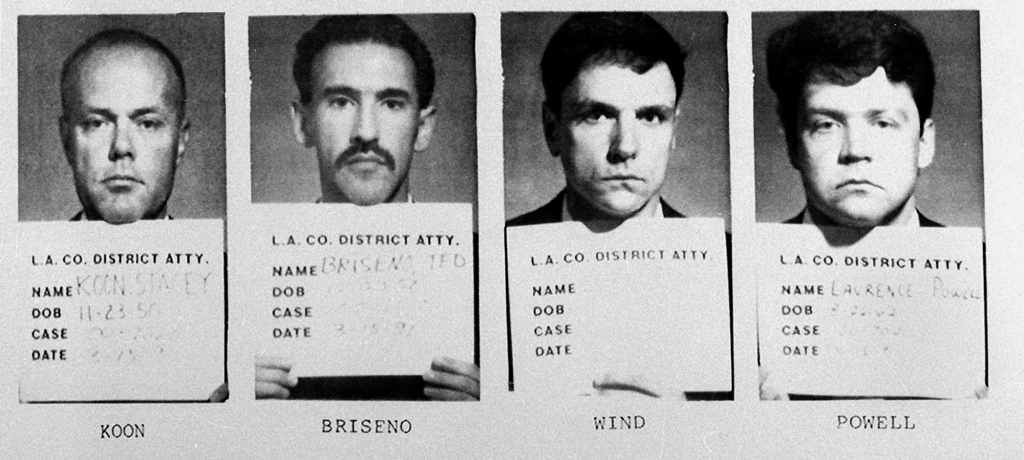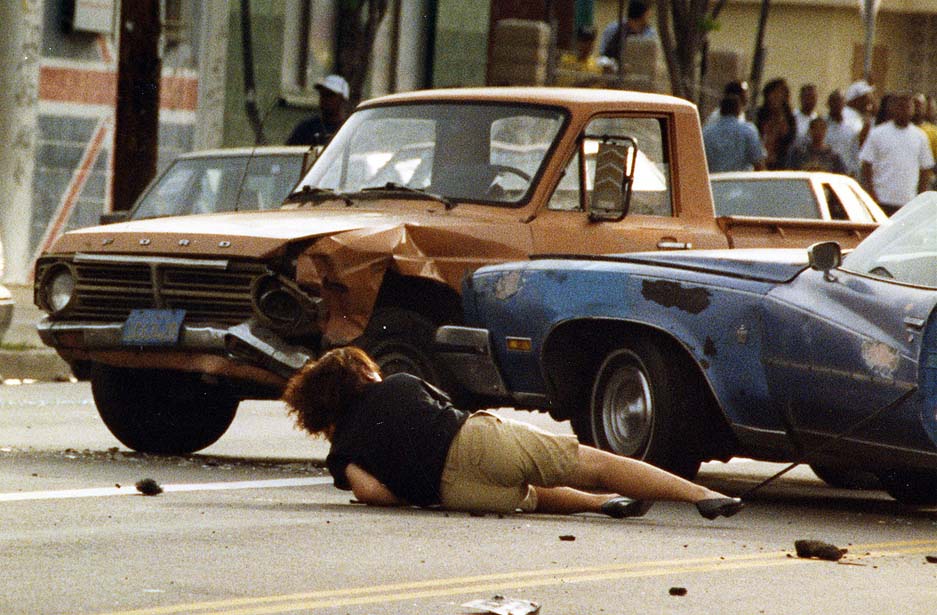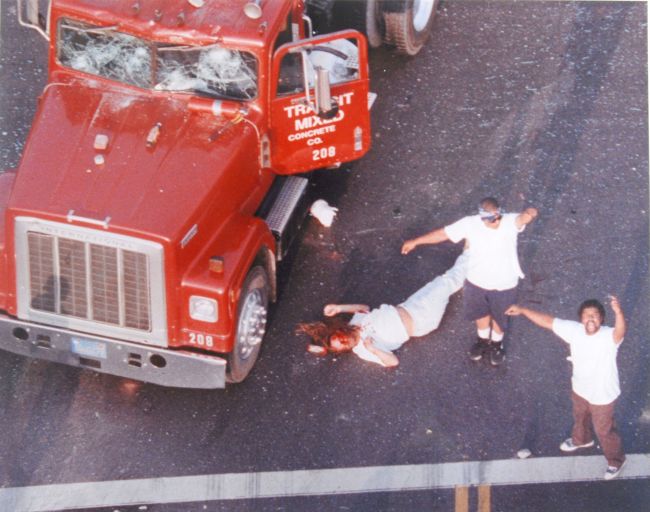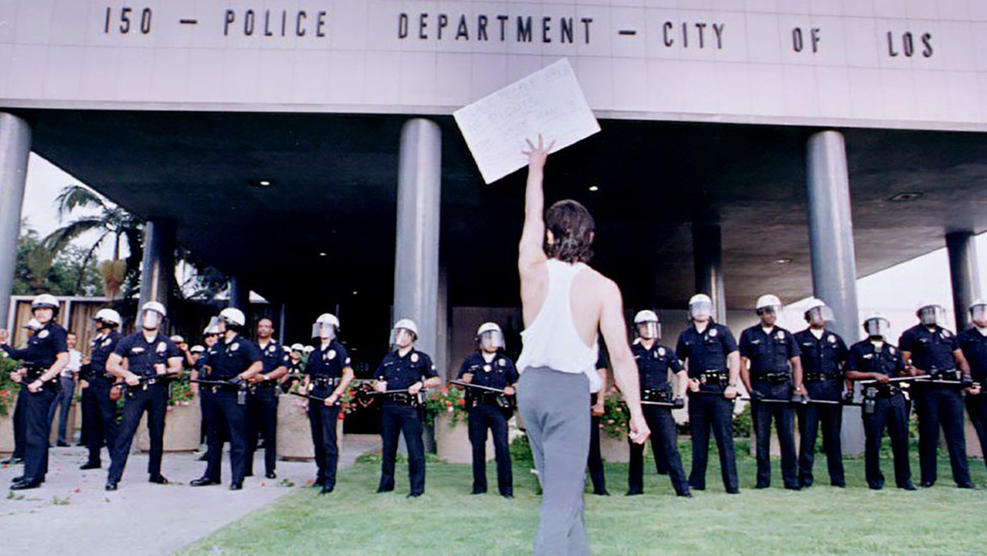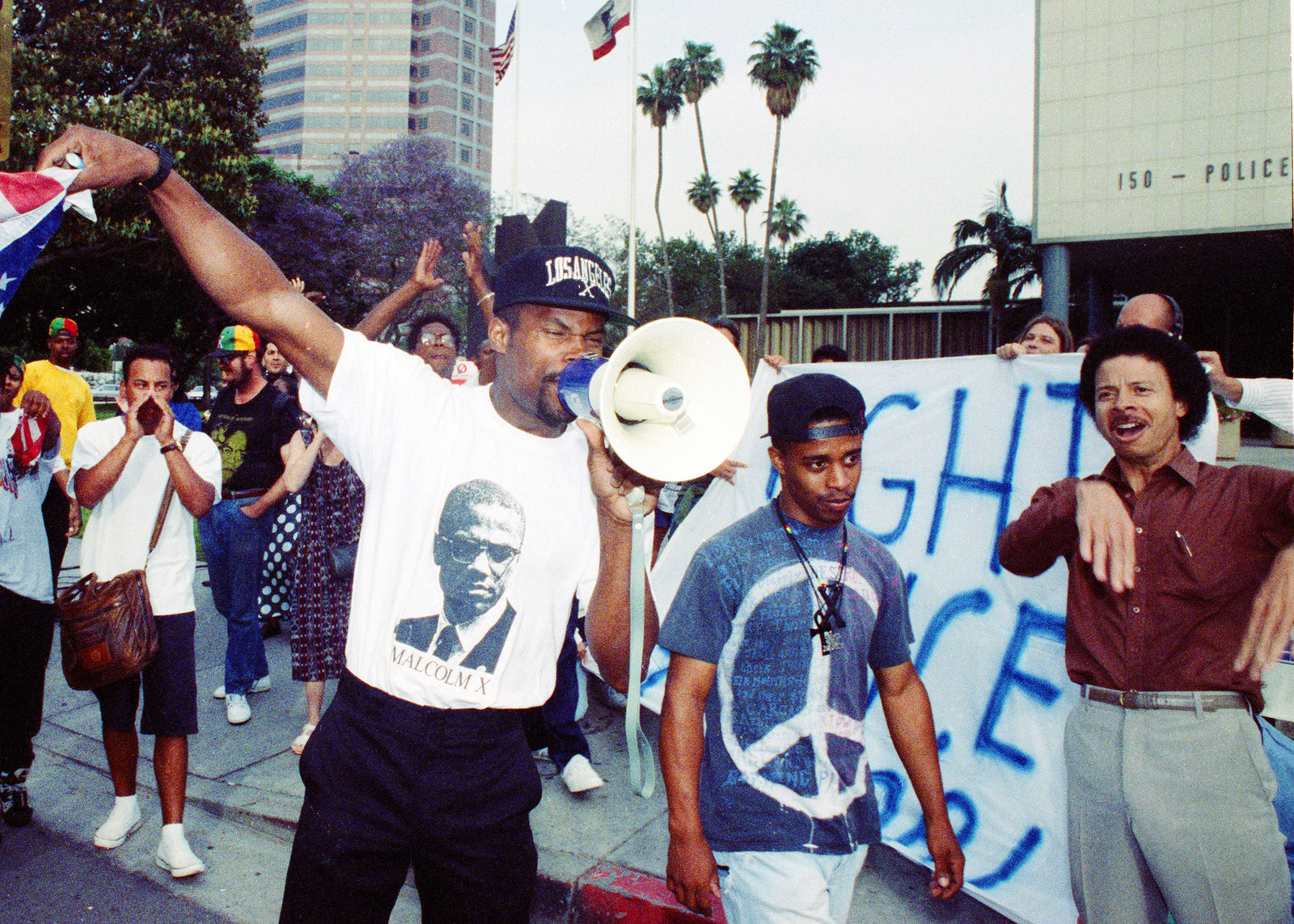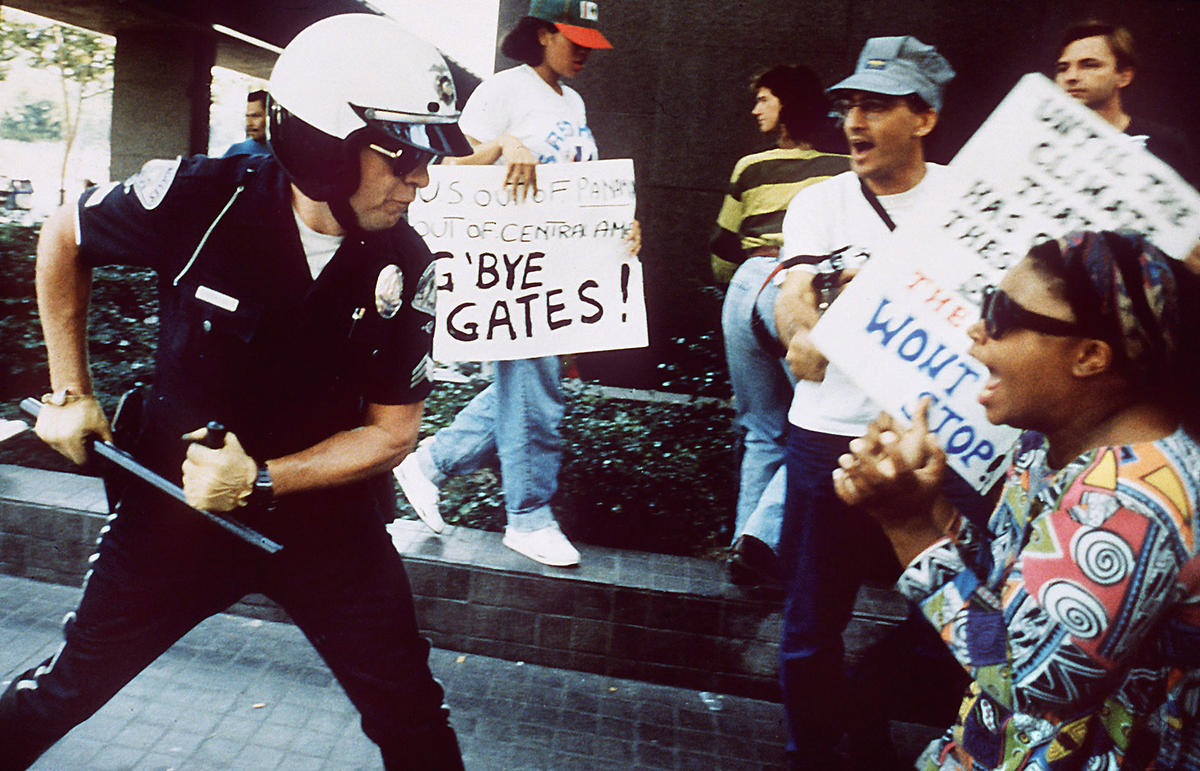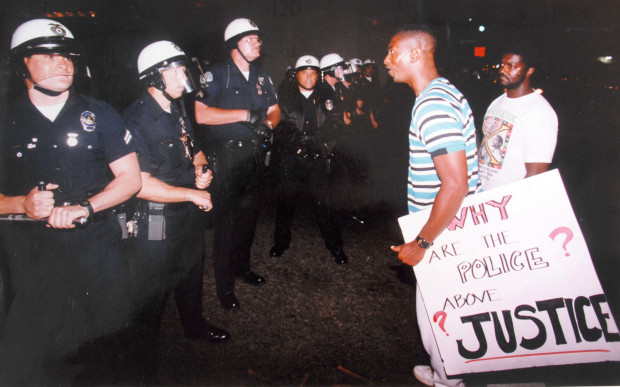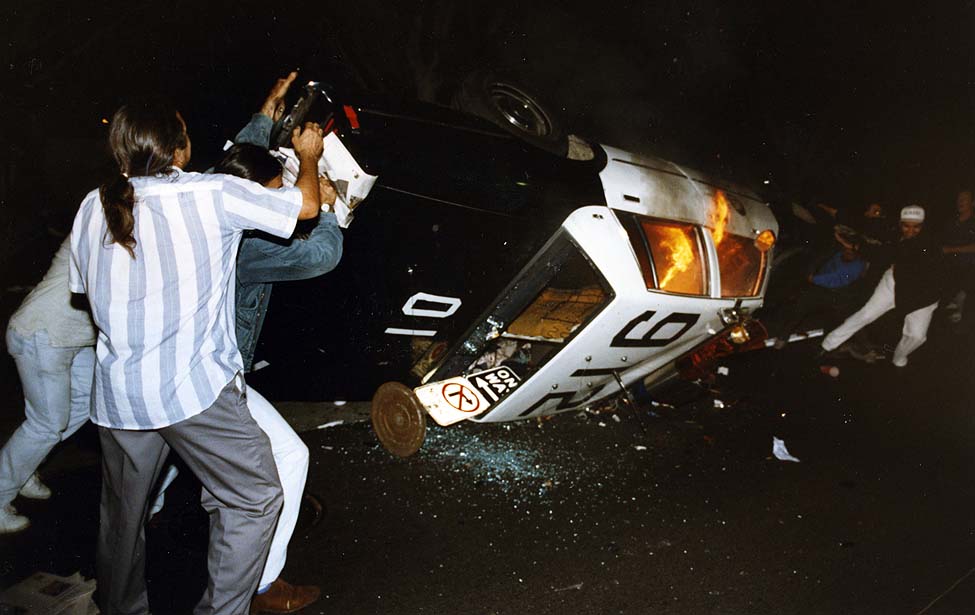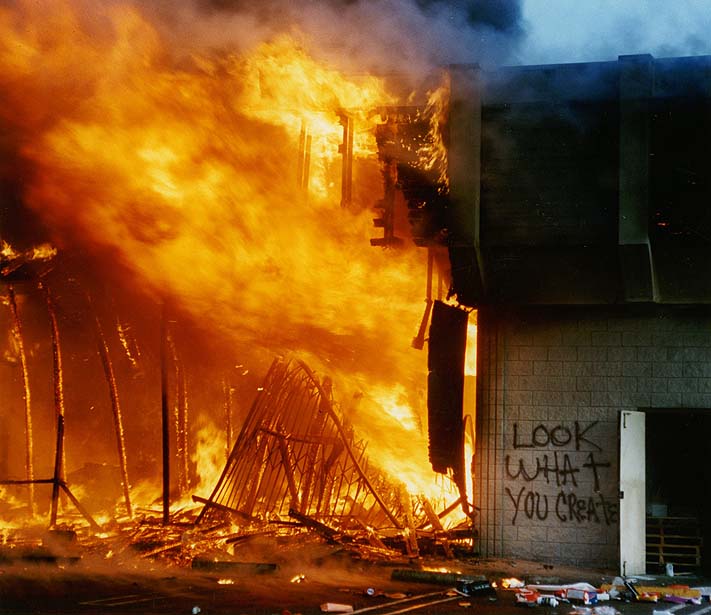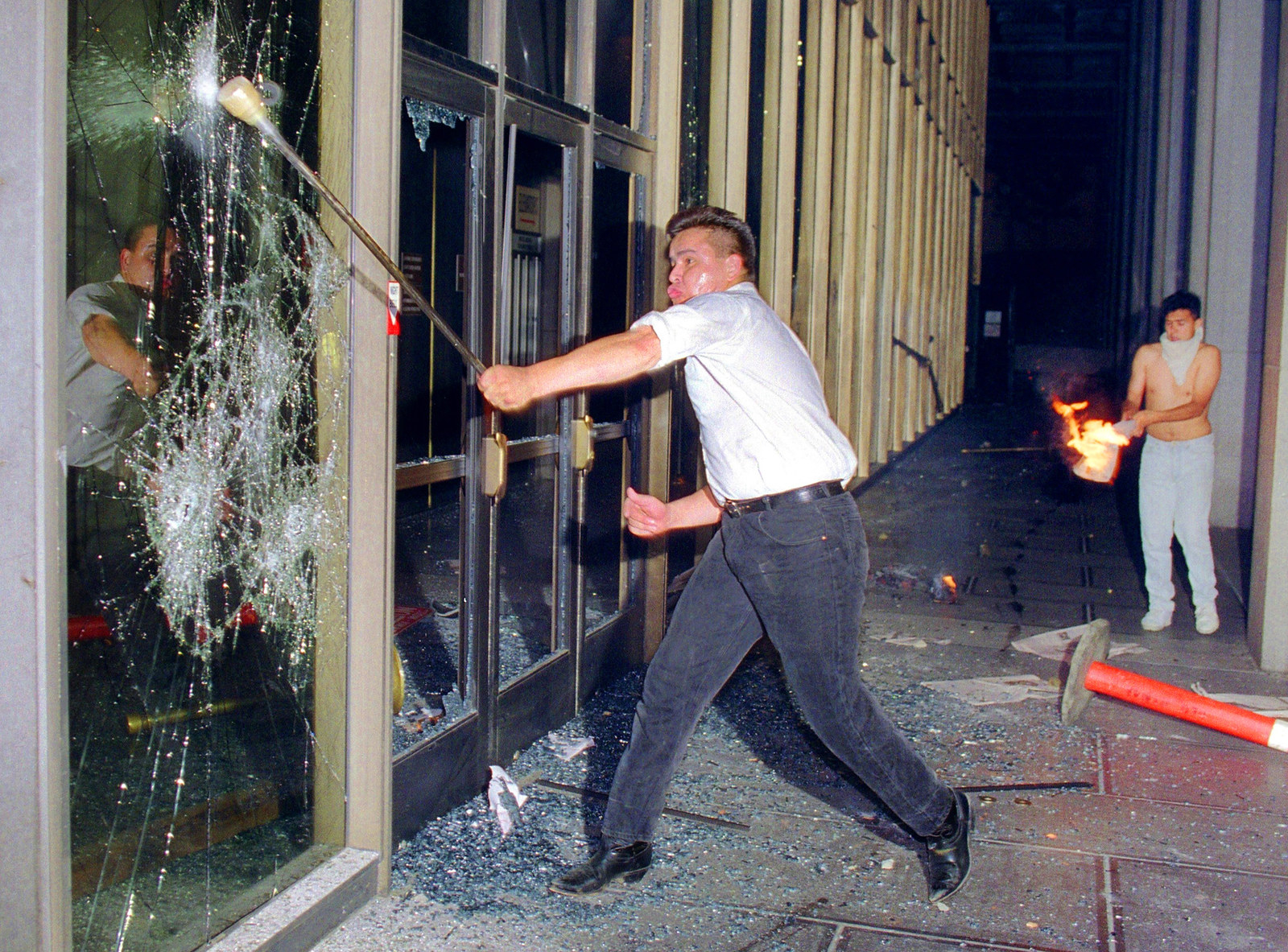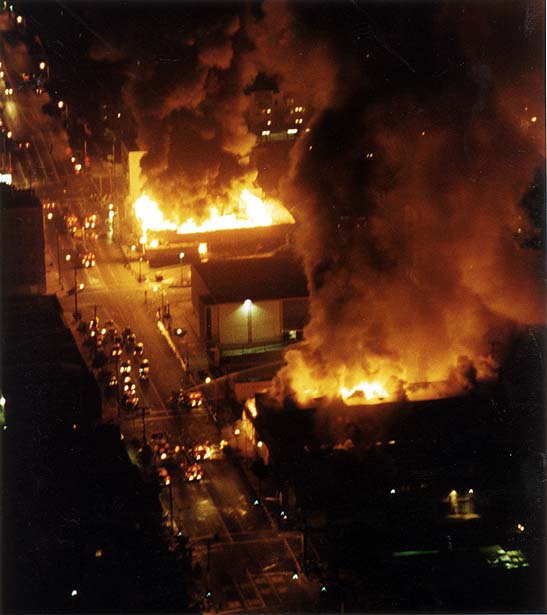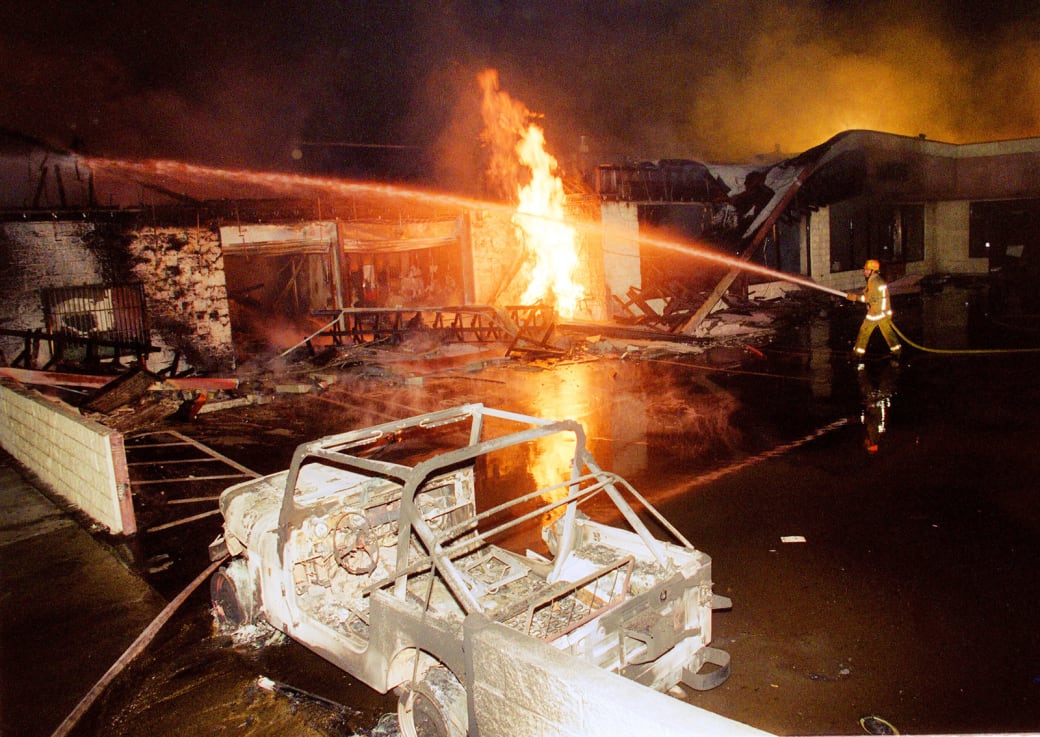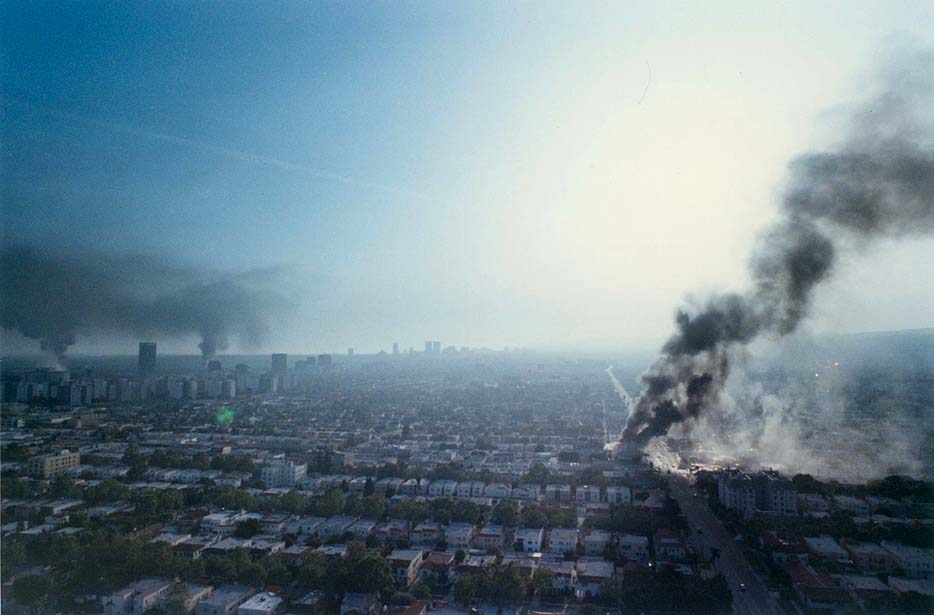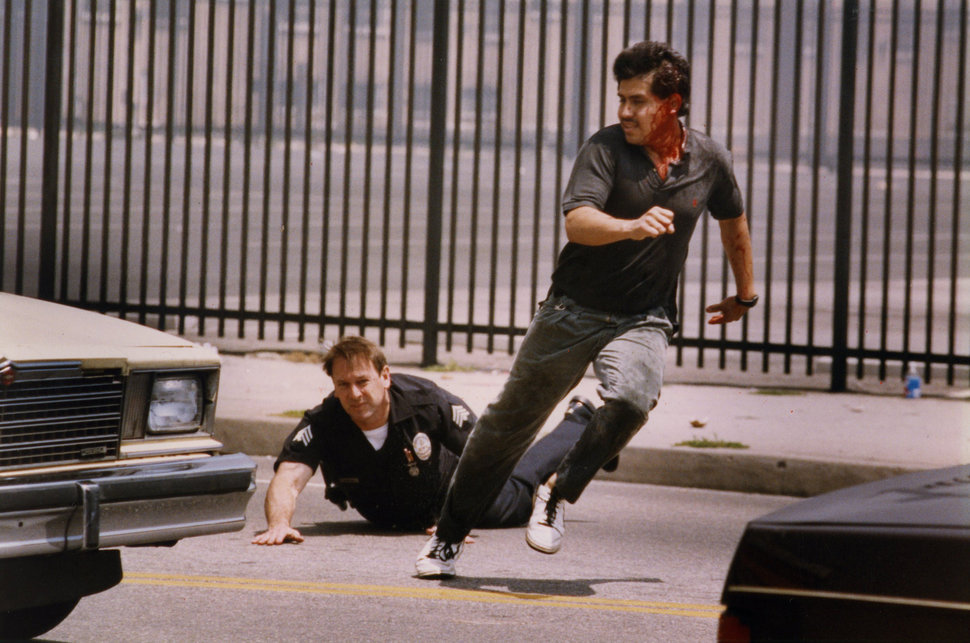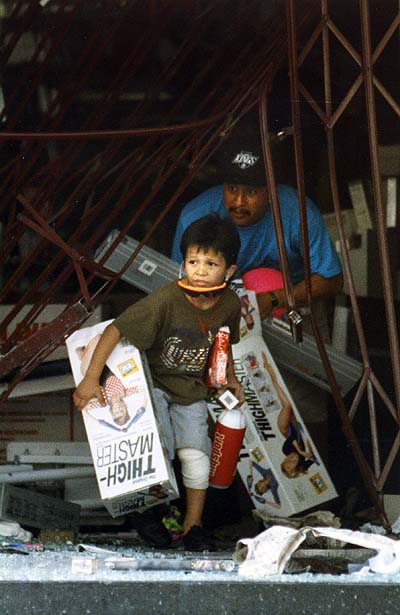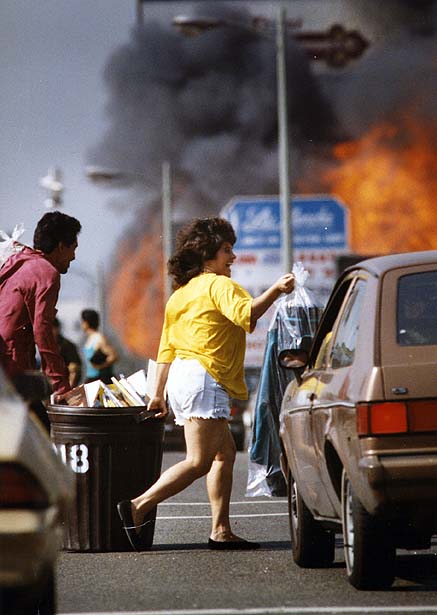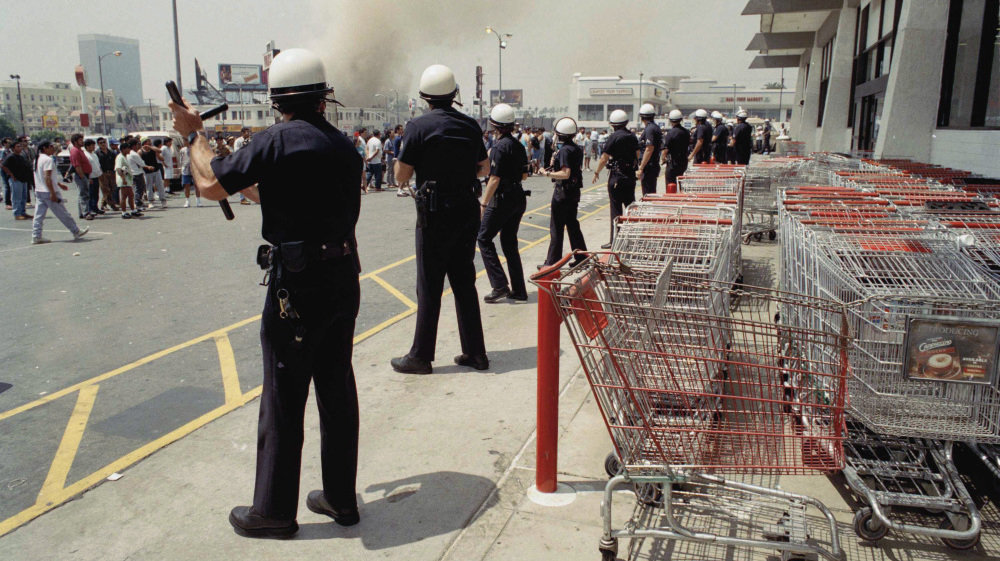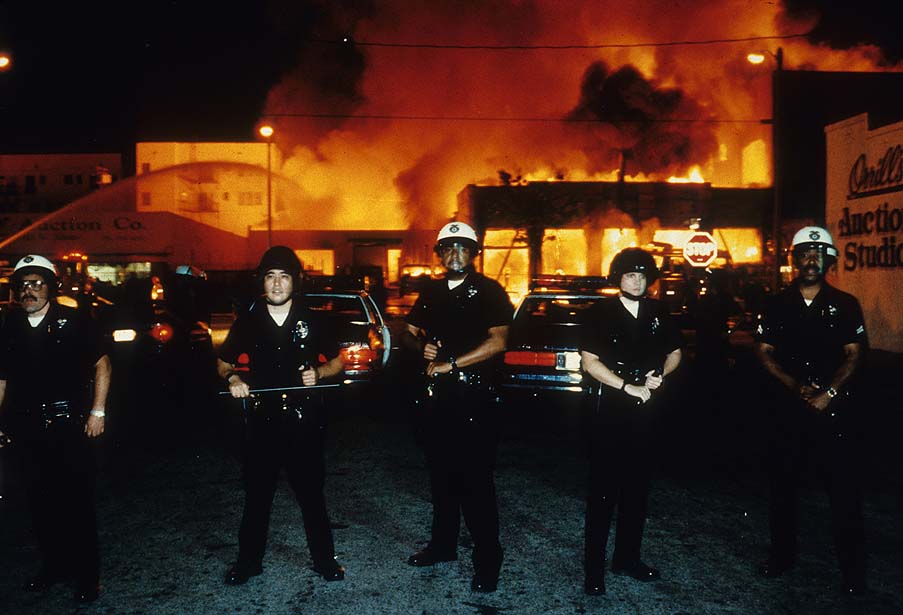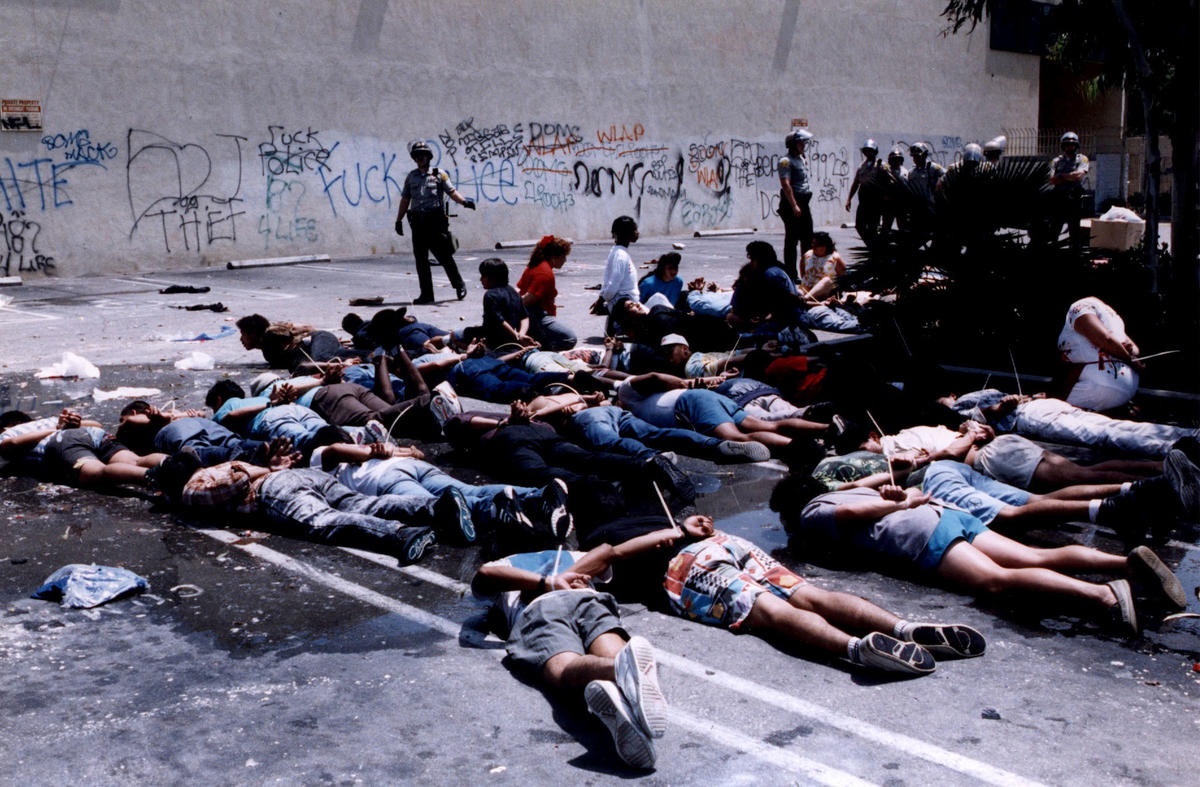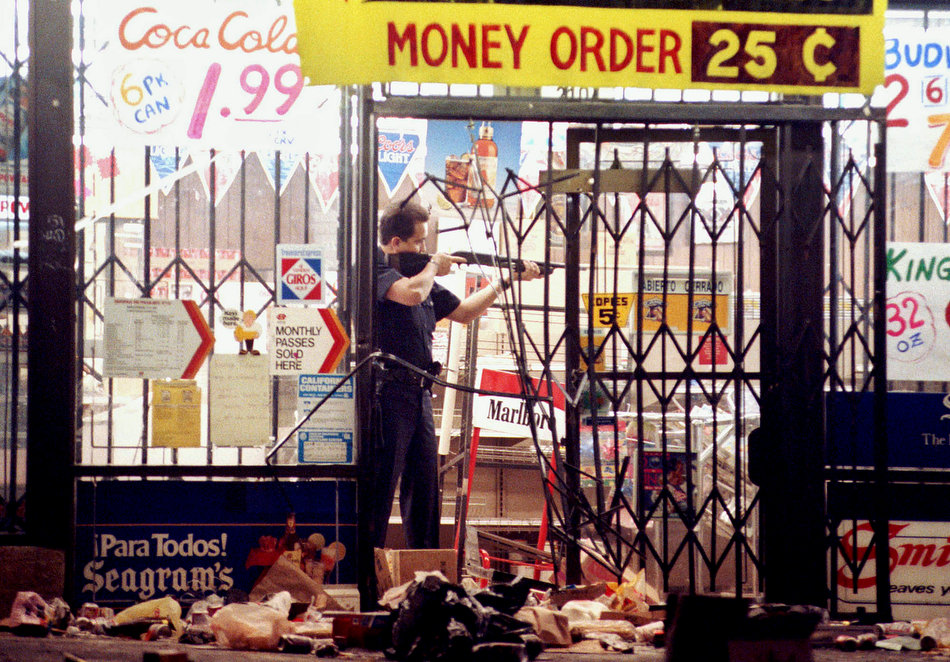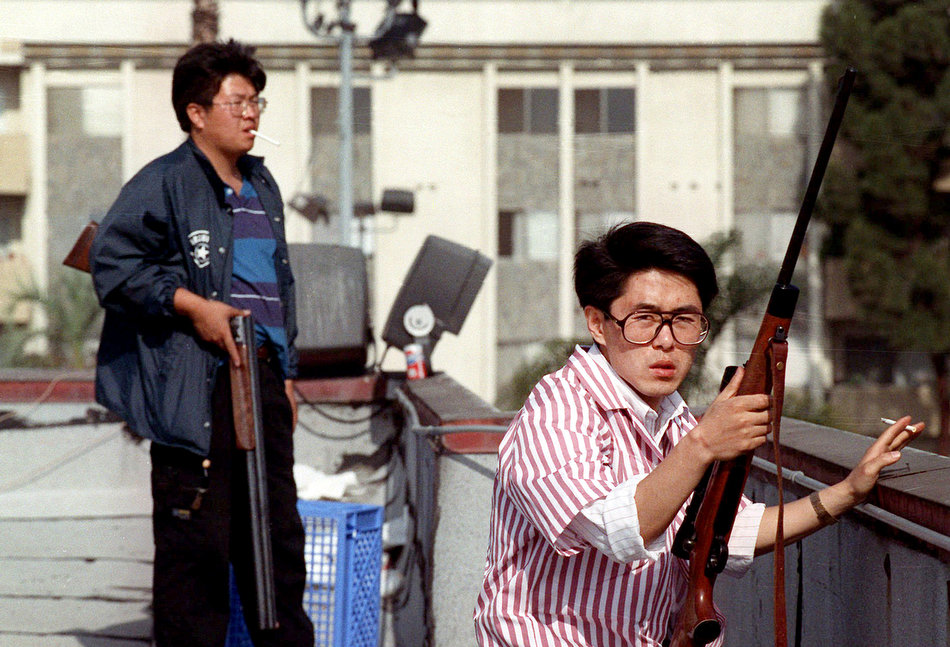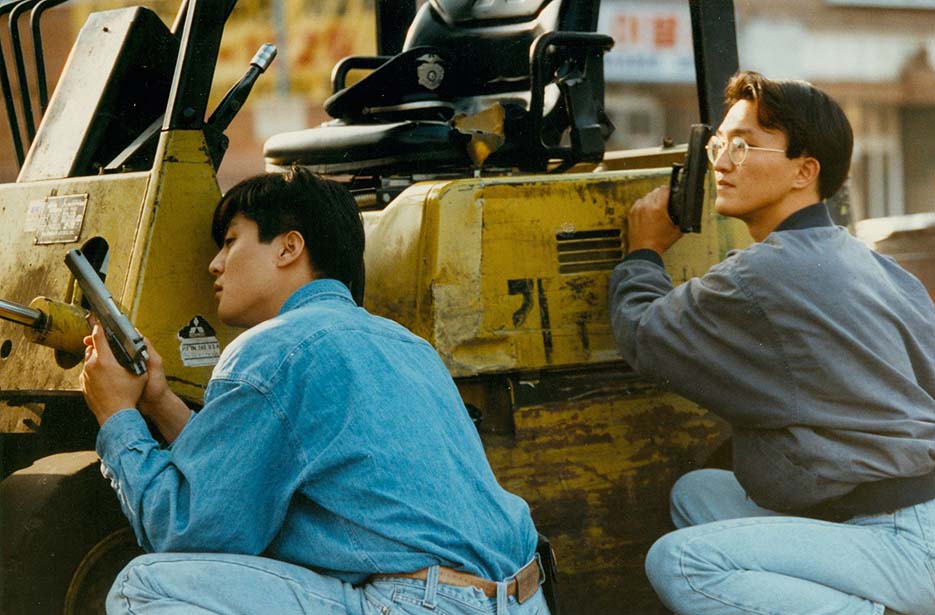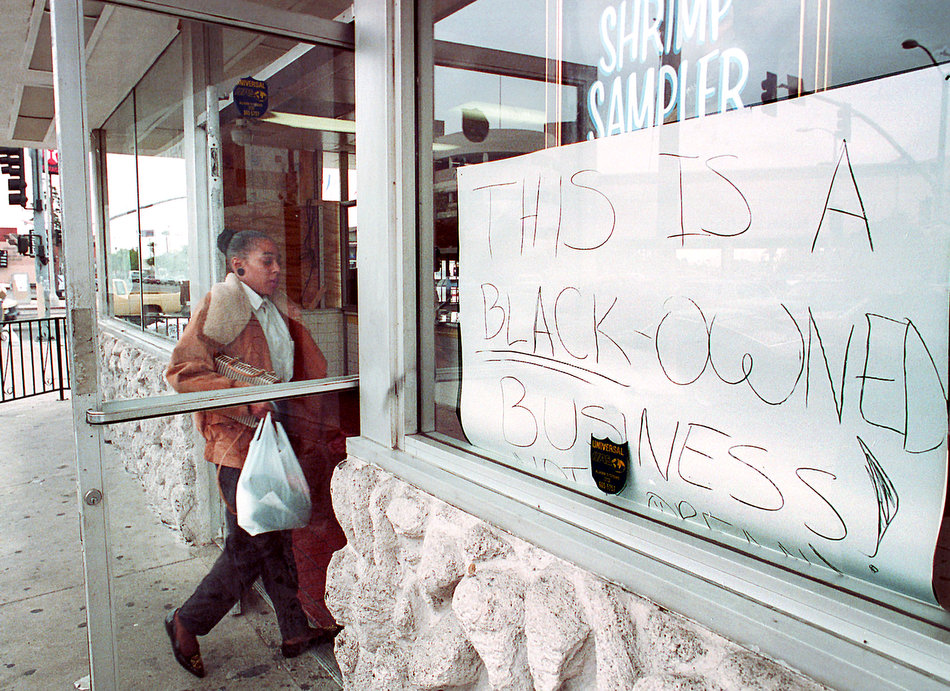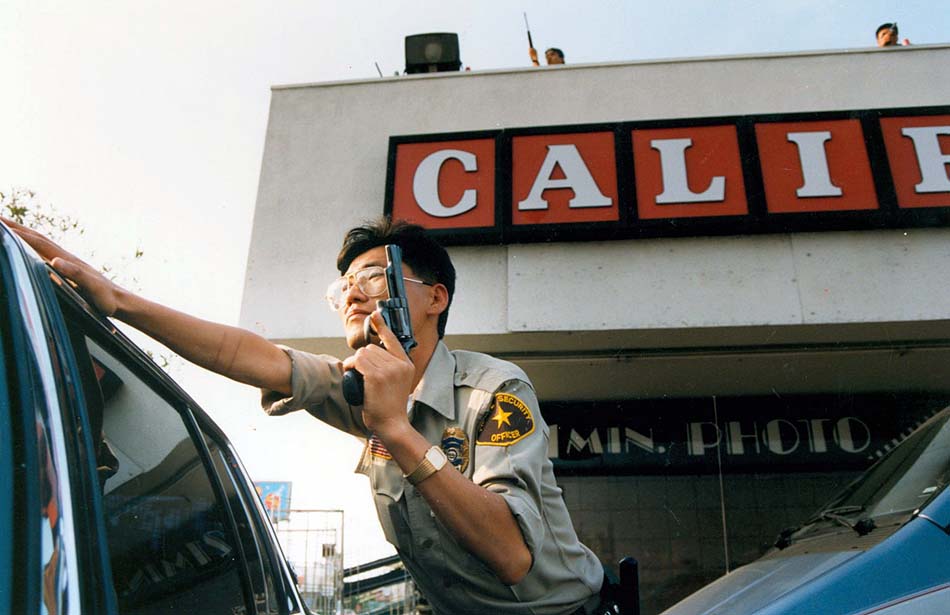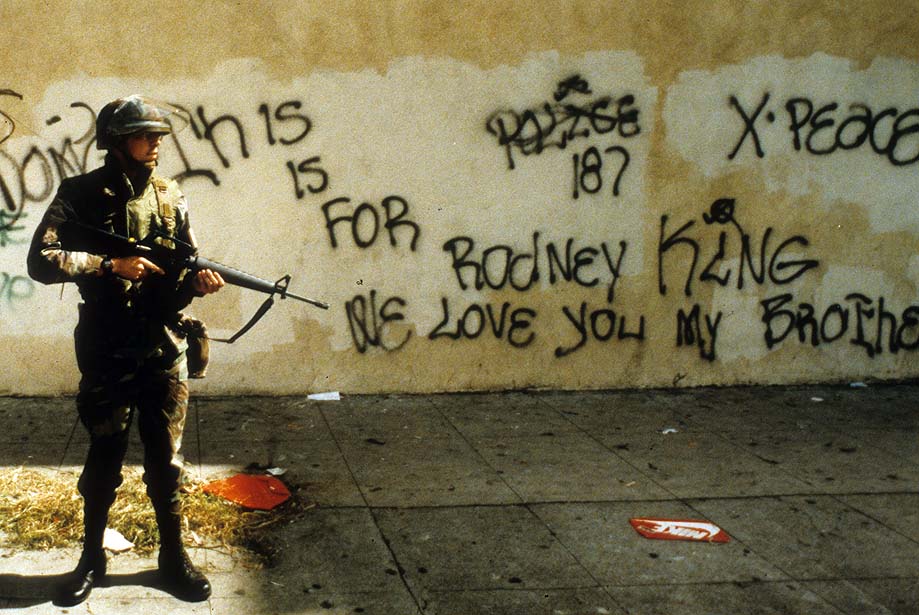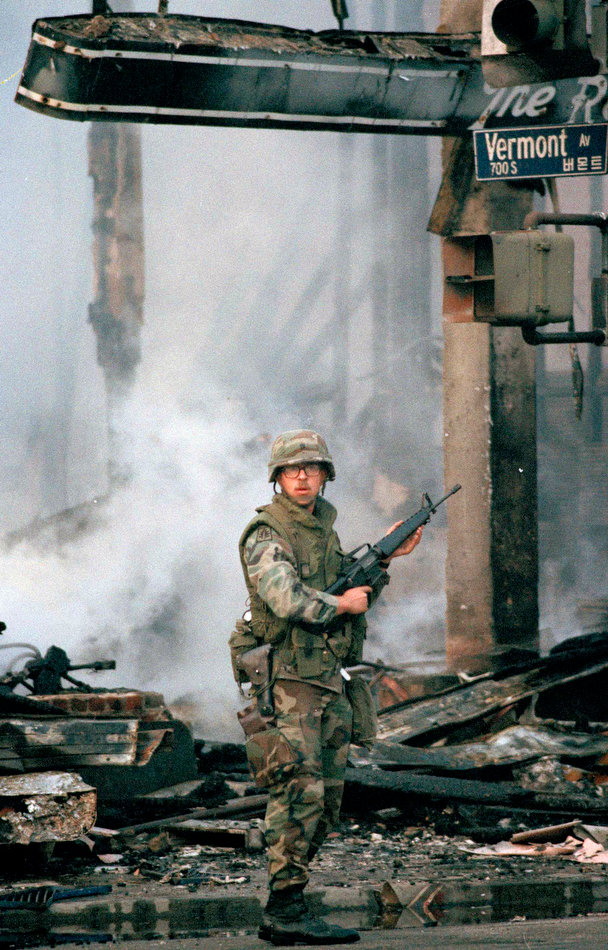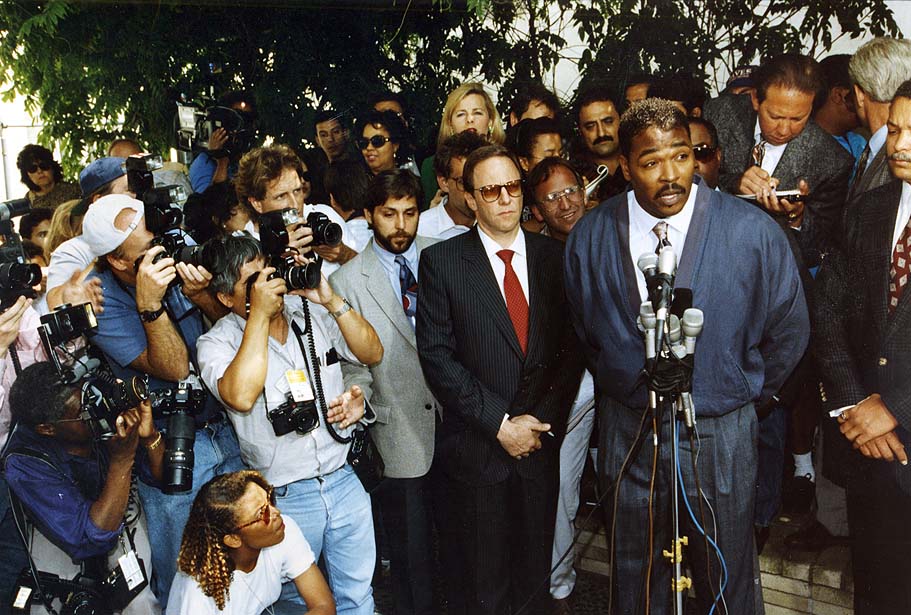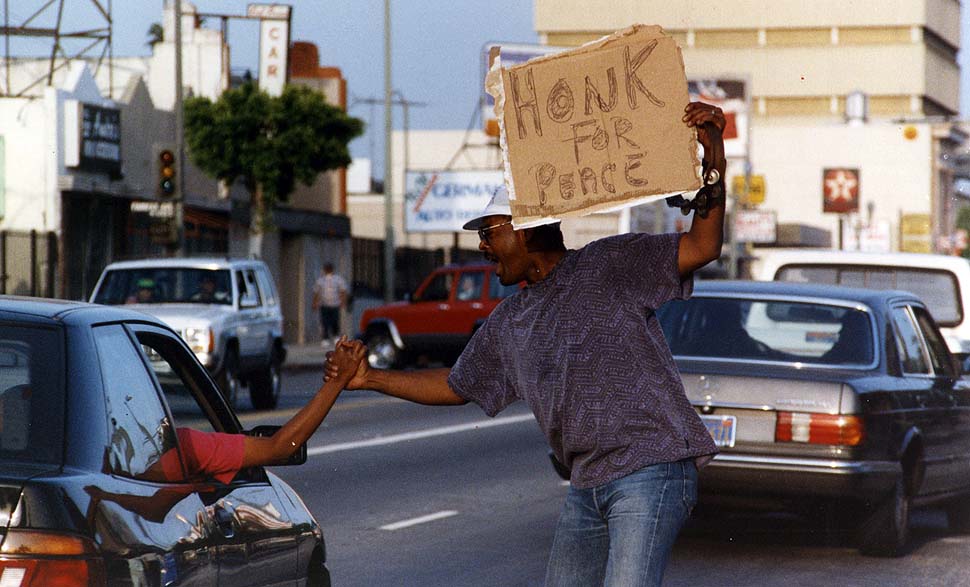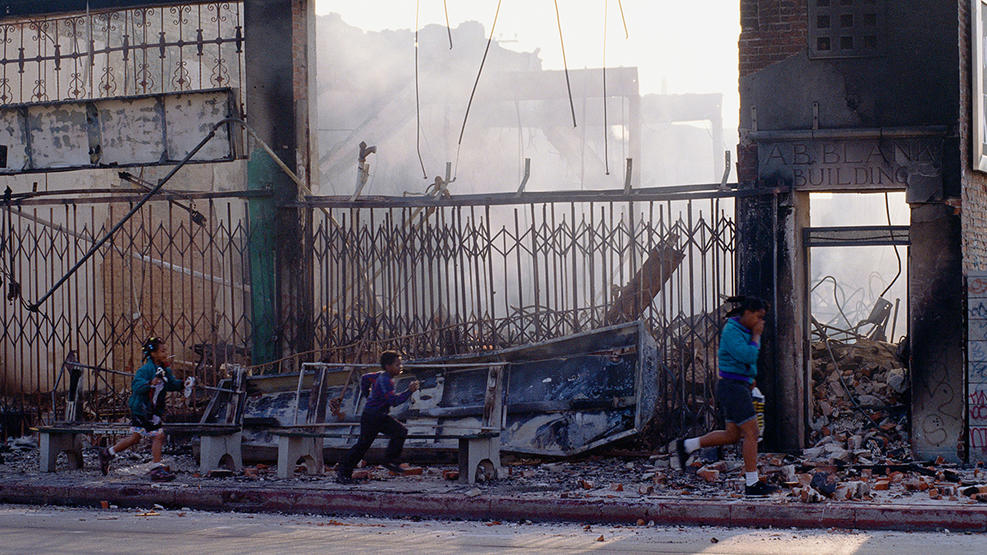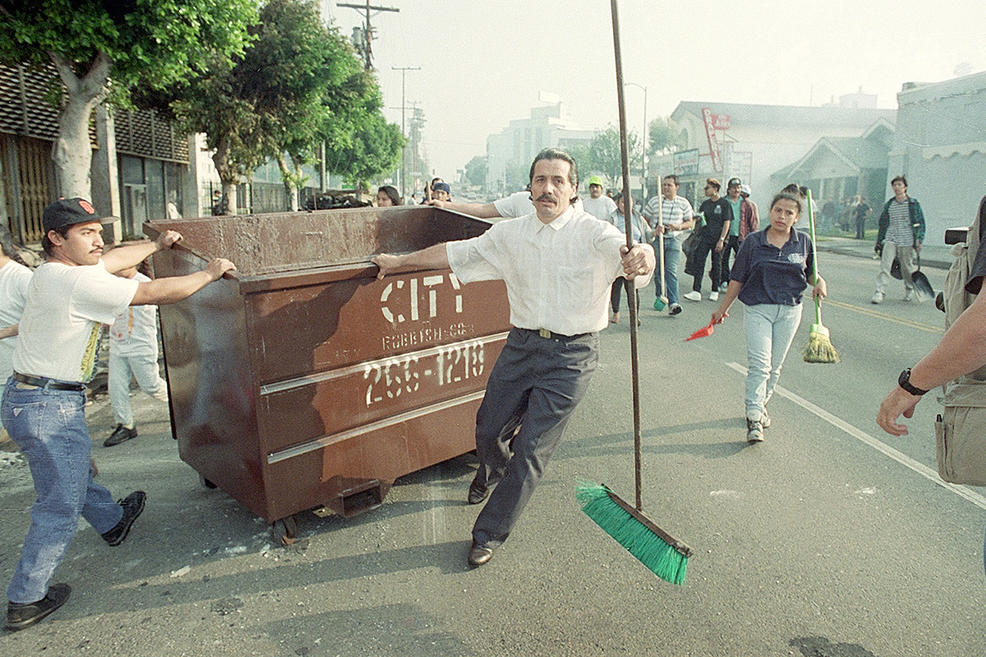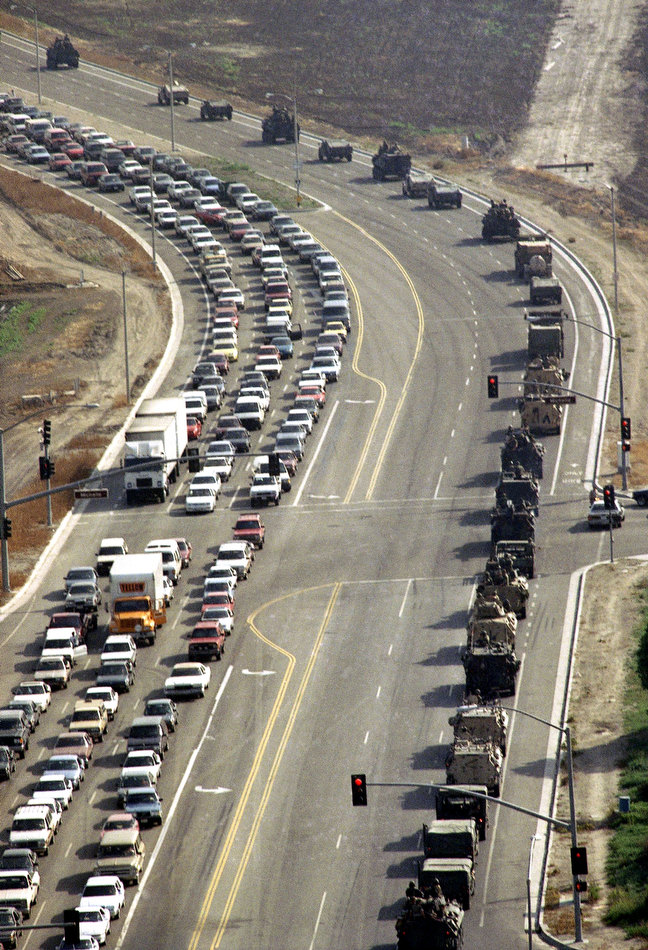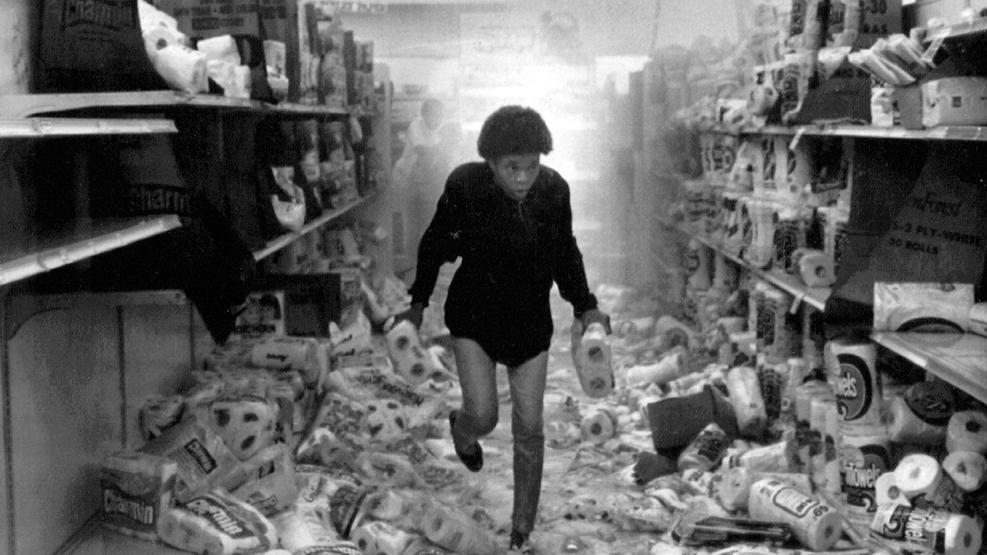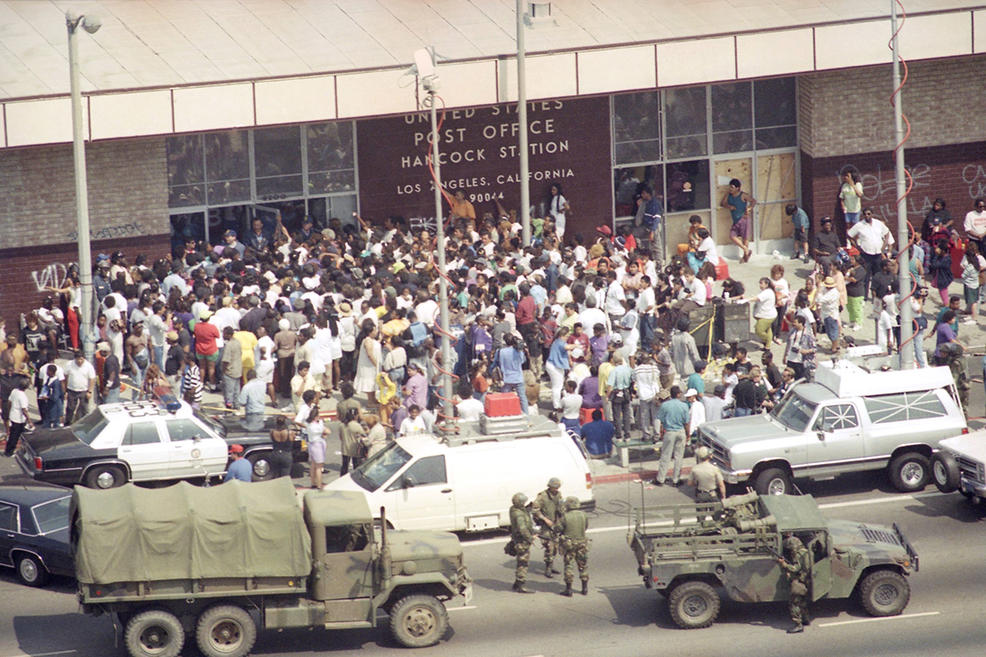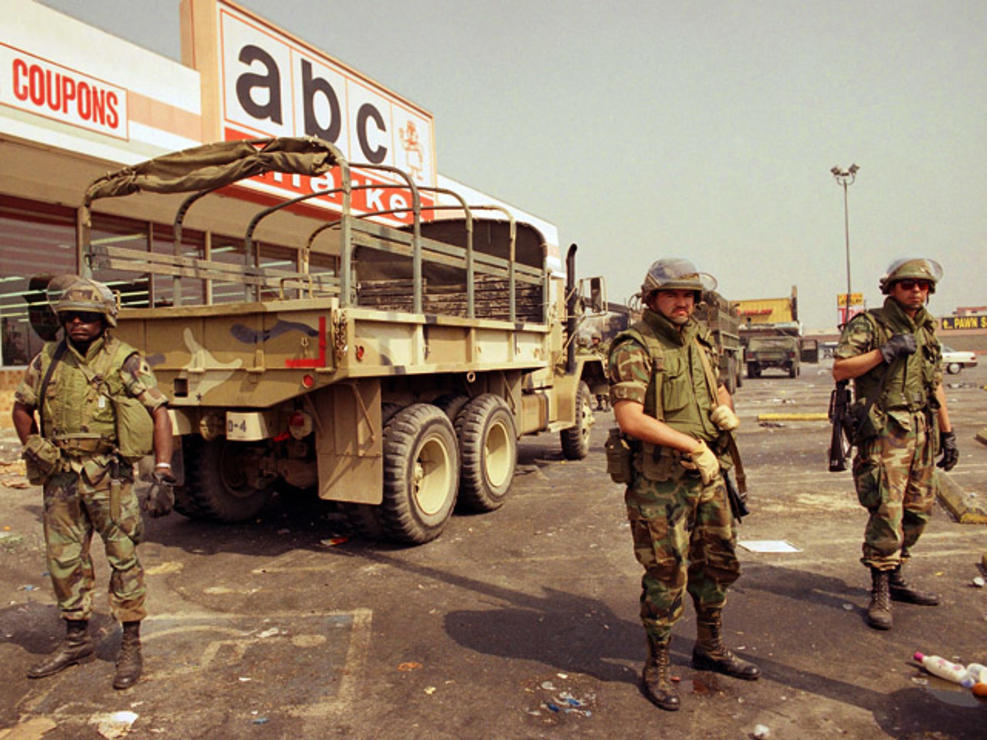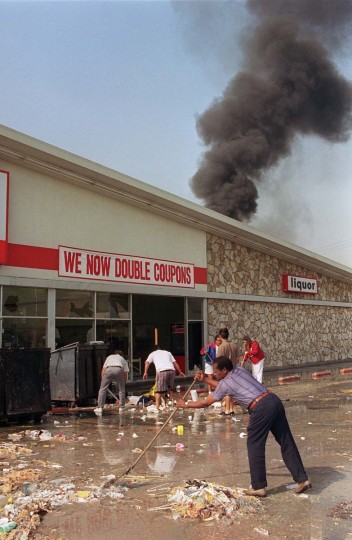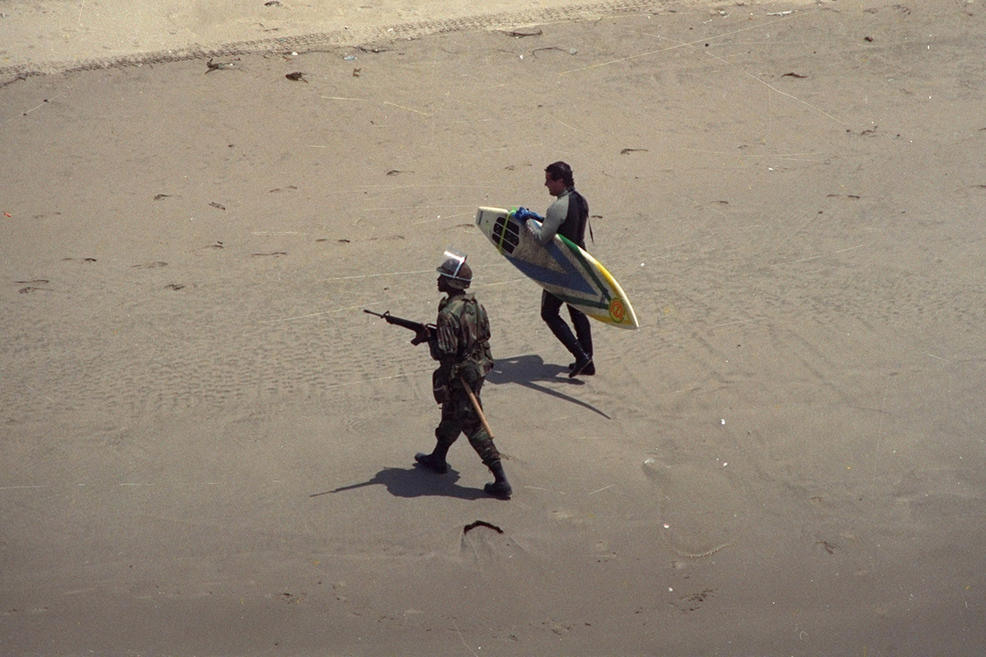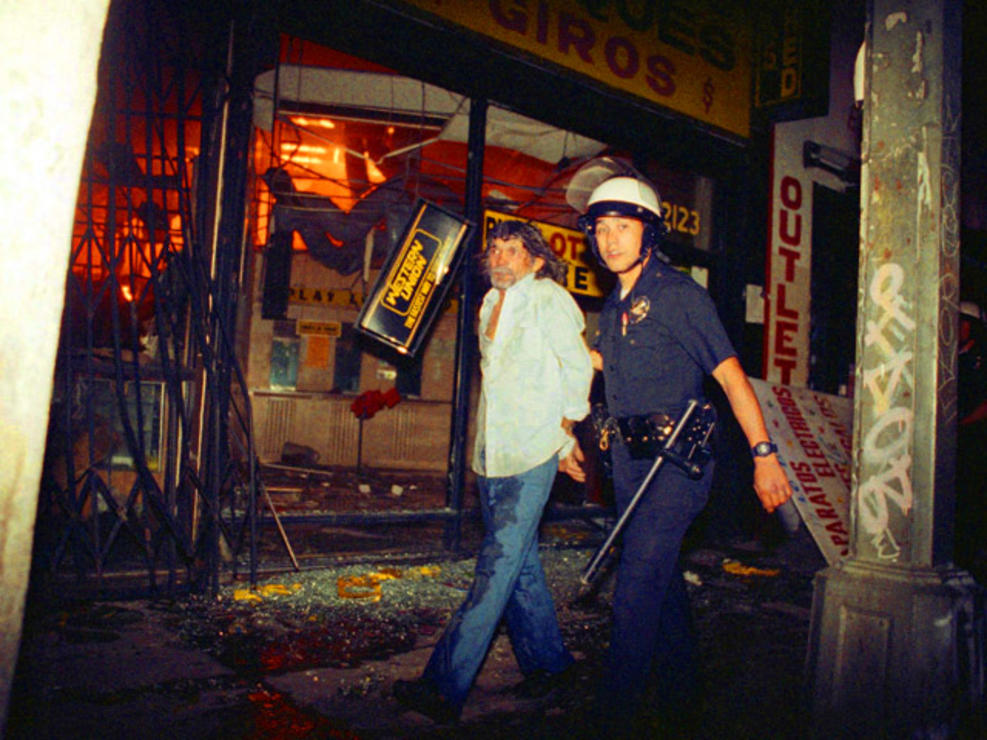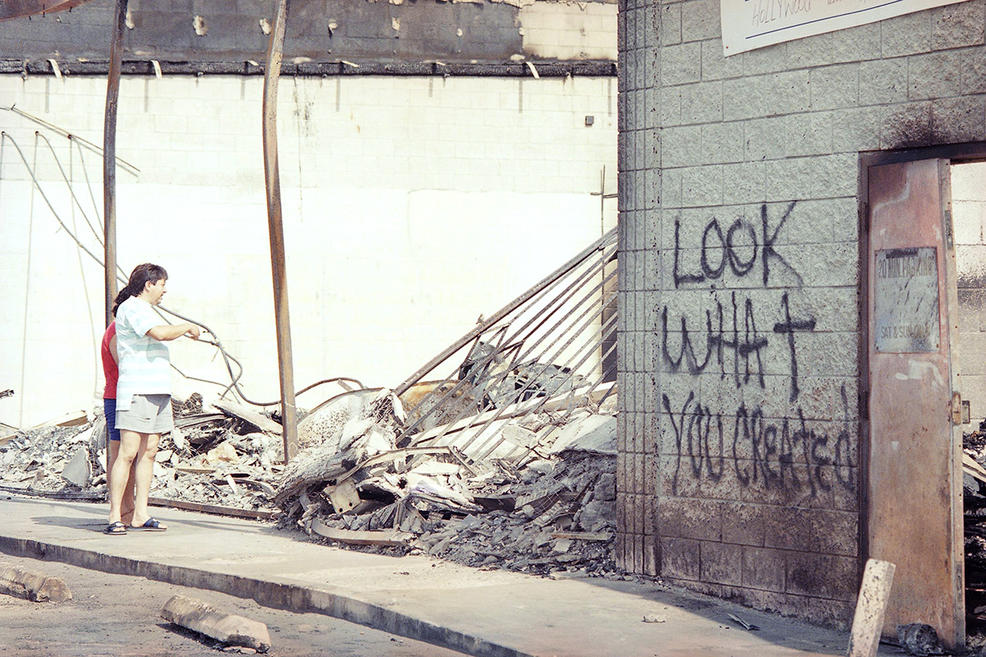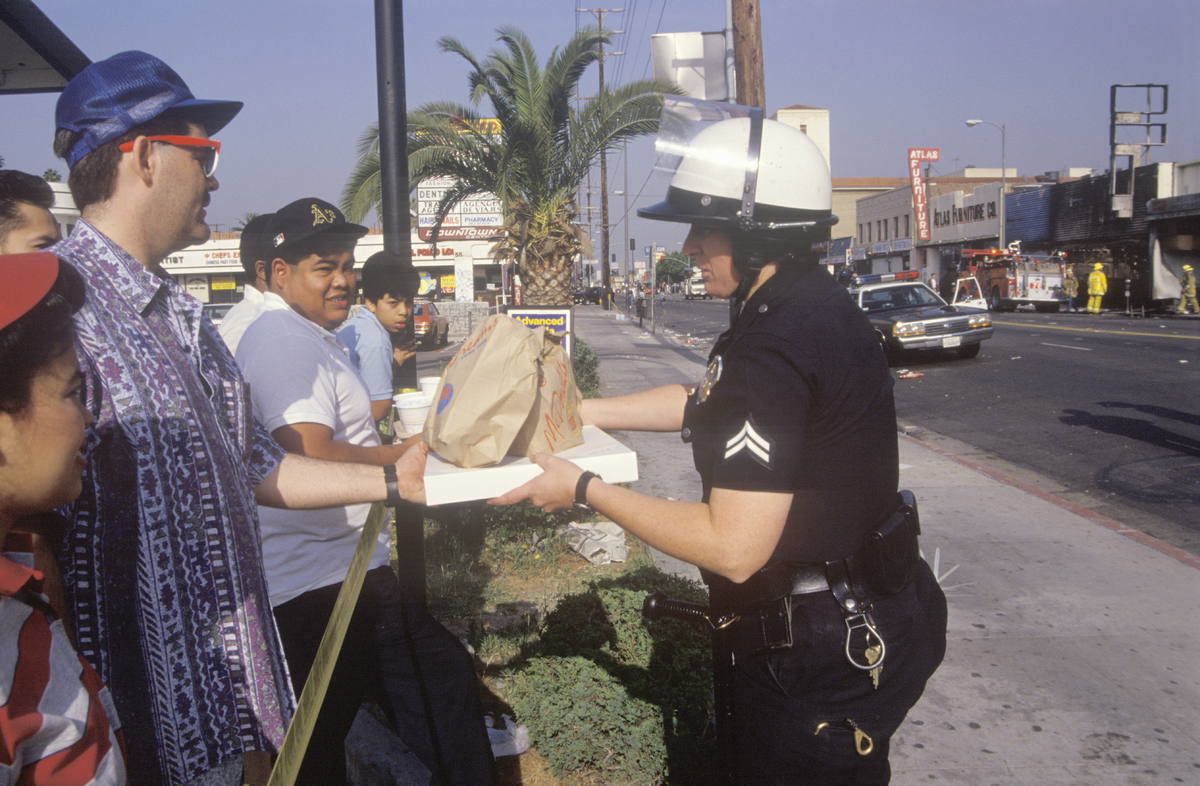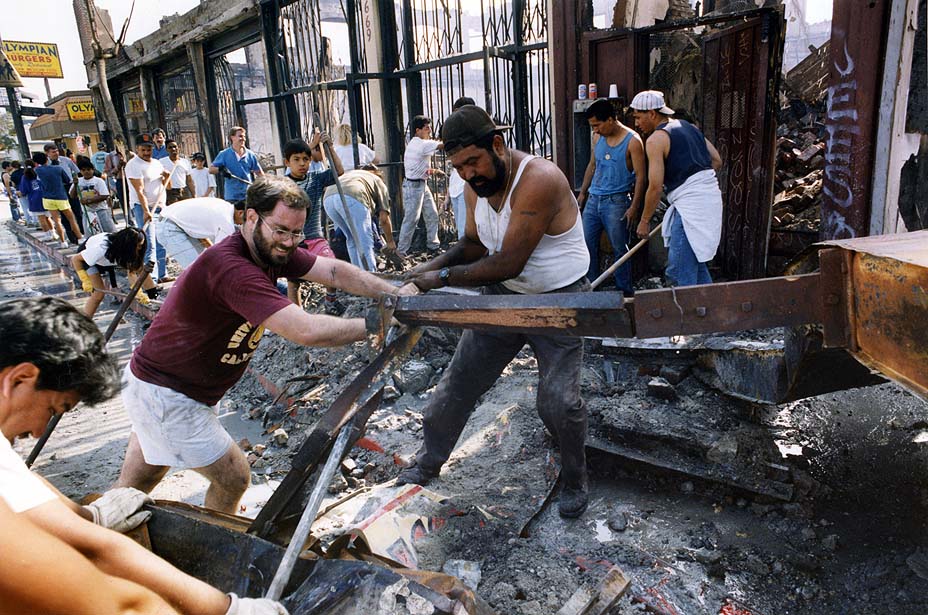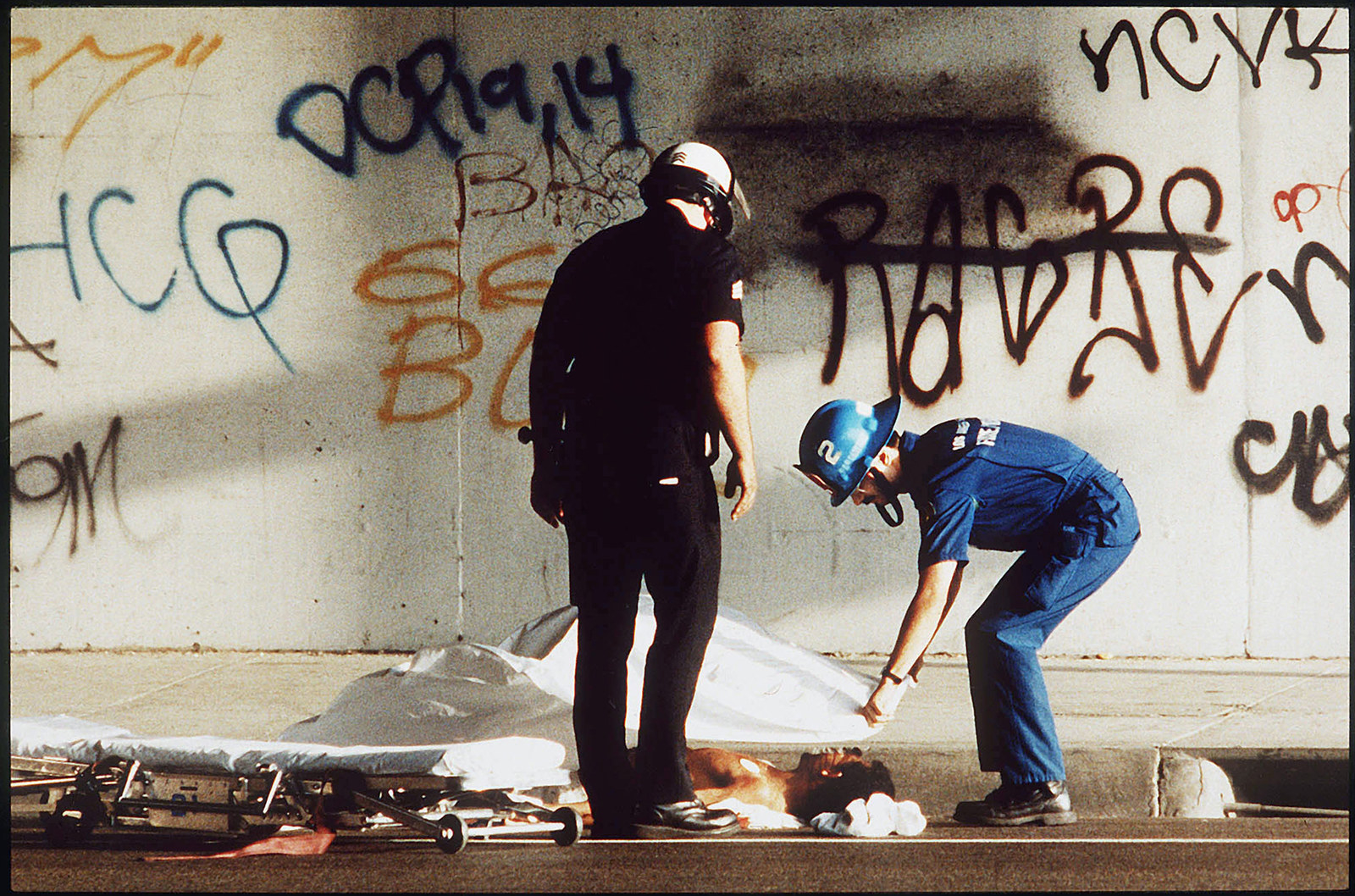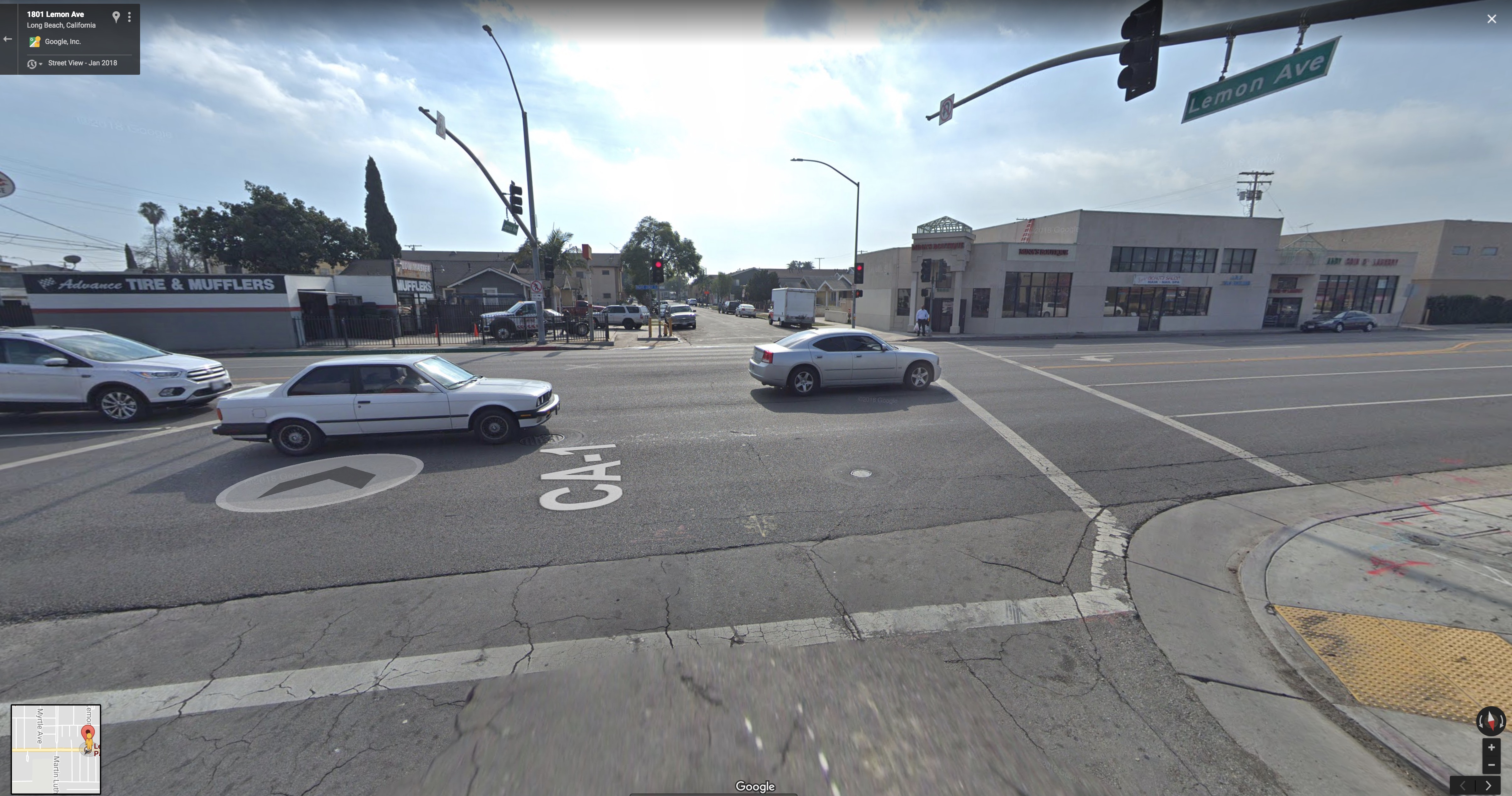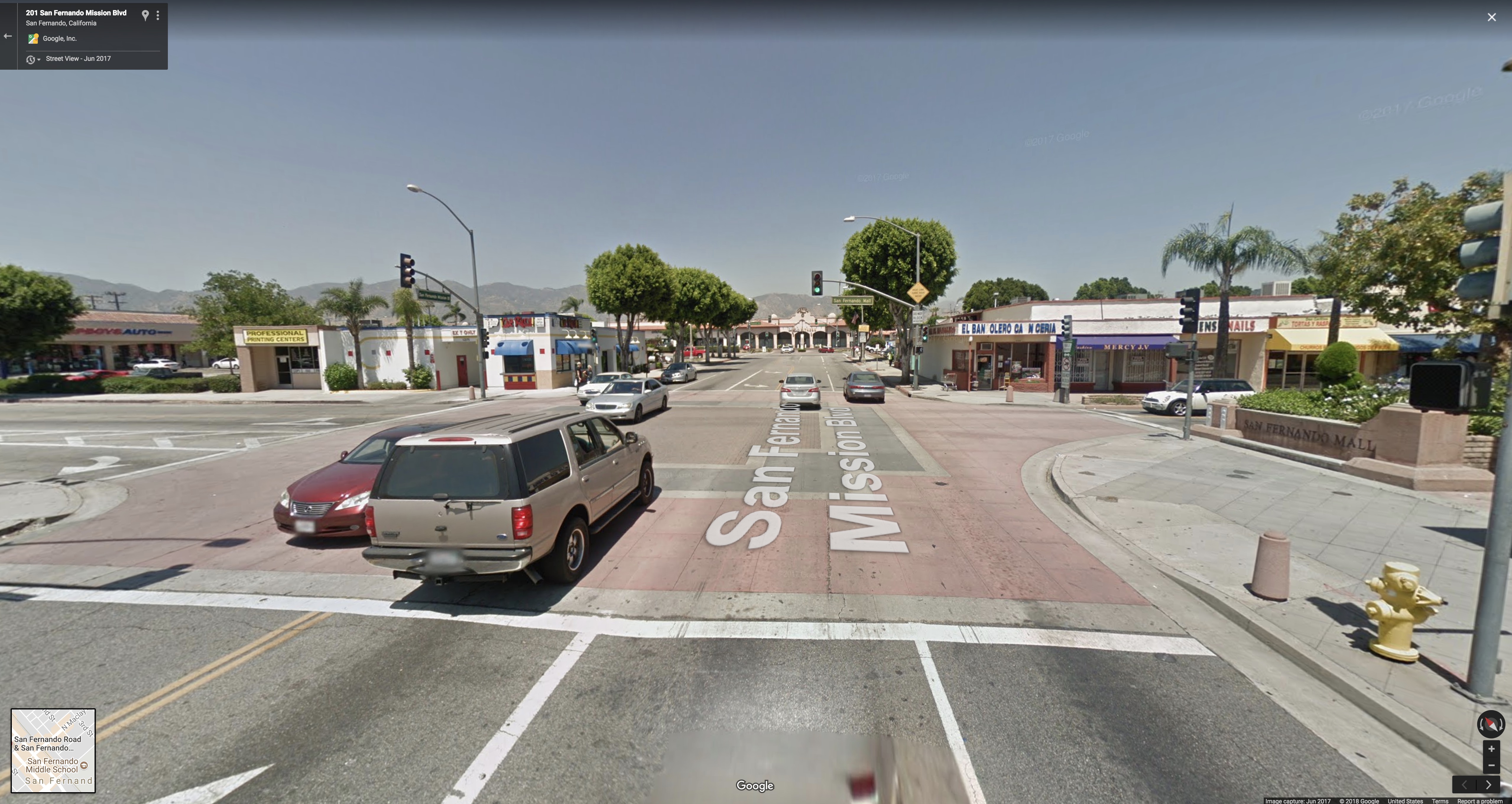
Sa-i-Gu
On April 29, 1992, the Los Angeles riots began with a gathering on Florence and Normandie where the police set a precedence that would recur throughout the coming days: they retreated. Sparked by the acquittal for the four officers involved in the Rodney King beating, and fueled by a growing distrust of the Korean-American community by the African-American community in Los Angeles after an incident a year prior when a Korean storeowner of Empire Liquor was essentially acquitted for the shooting and killing 15-year old Latisha Harlins, Los Angeles became a war zone with its targets set on Korean-American businesses. Over 2,000 of the 3,100 businesses looted or destroyed were owned by Korean-Americans. The police abandoned Angelenos to fend for themselves, which resulted in a surge of gun purchases by the Korean-American community to defend their businesses.
This graphic takes a look at the hour-by-hour rundown of the chaos and action taken as detailed by the Los Angeles Times’ 2002 article titled “Charting the Hours of Chaos.” The events have been aligned to the hour of the day it took place, while the day of the event has been mapped starting from the inner circle moving outwards to show the progression of days. The red circle indicates violence occuring over 24 hours with 12 hours representing one full cycle. Darker red means two 12-hour cycles.
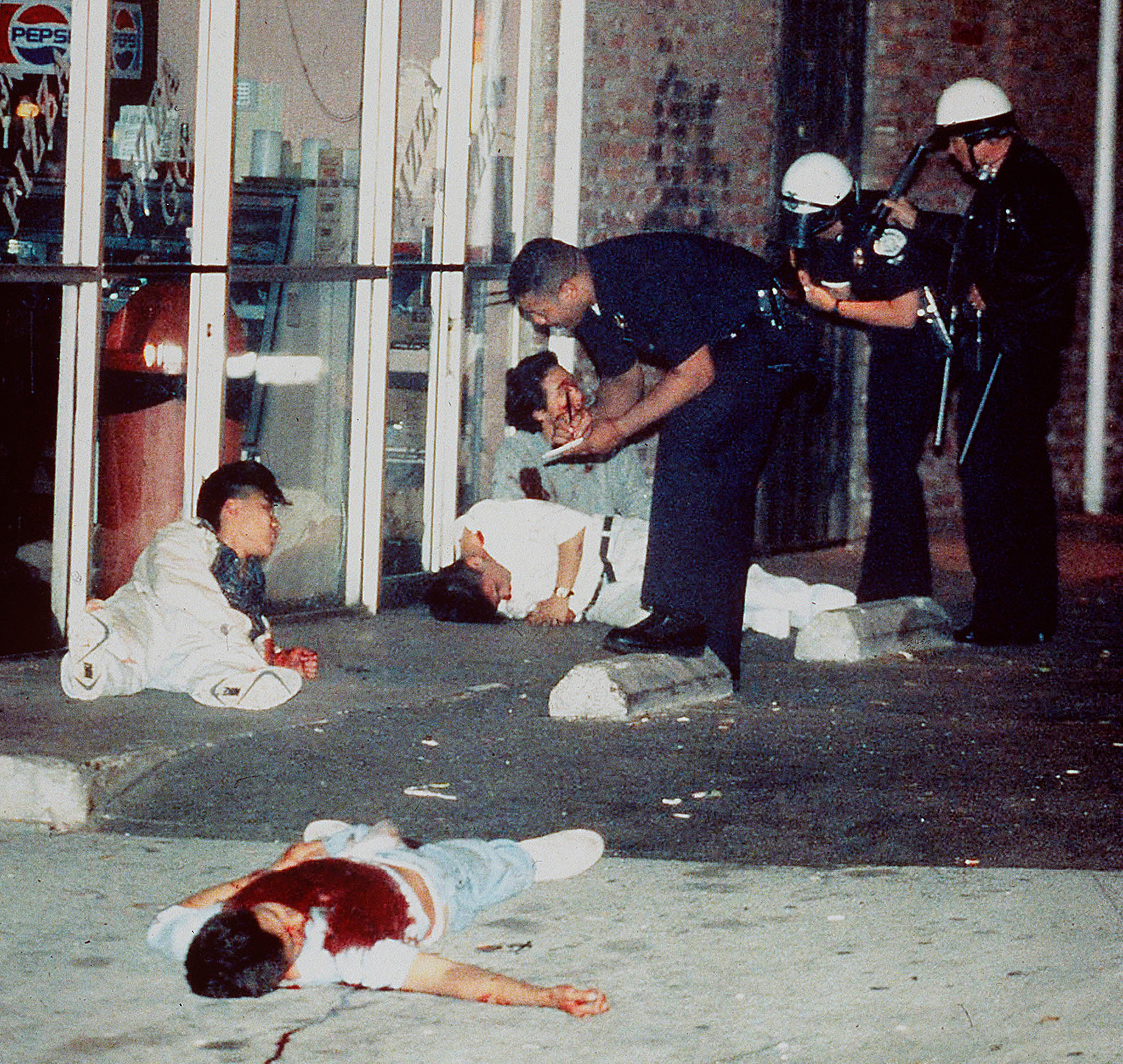
Hyungwon Kang / Los Angeles Times

AP Photo/Paul Sakuma

Pacific Ties/Kore file

David Longstreath / AP Photo

Google Maps

AL SEIB / LOS ANGELES TIMES
Just before midnight
Bradley and Wilson announce they have requested more National Guard troops to bring the Los Angeles County total to 6,000. They also ask the U.S. military to be placed "on alert."
12 to 2:30 p.m.
The National Guard is officially deployed. By late afternoon, hundreds of troops take up positions in hot spots around the city.
12 to 3 p.m.
The Rapid Transit District announces that all bus service will be suspended as of 6 p.m.
More than 1,000 Korean Americans and others gather at a peace rally at Western Avenue and Wilshire Boulevard.
About 1 p.m.
Gov. Wilson and Mayor Bradley talk with President George H.W. Bush and other officials in Washington about deployment of federal troops.
1:15 to 5:30 a.m.
Smoke along Washington Boulevard becomes so thick that it impairs visibility of Blue Line train operators. Passengers are taken off the train and shuttled by bus from the 7th and Figueroa station to the station at Washington and Long Beach Avenue.
1 to 6 p.m.
Harbor Freeway (110) off-ramps are reopened.
1 p.m.
Pomona declares a state of emergency and imposes a dusk-to-dawn curfew.
About 2:45 p.m.
About 2:30 p.m.
Officials in Washington and Los Angeles announce that a federal grand jury has been convened and indicate that the Justice Department is likely to seek criminal indictments of the four officers involved in the King beating.
About 2 p.m.
Rodney G. King, the man whose videotaped beating created a national furor over police brutality, breaks his long silence to speak out about the violence inflicted in his name. In a brief emotional statement he asks: "People ... can we all get along?"
Three LAPD officers are acquitted and one is partially acquitted in the videotaped beating of motorist Rodney G. King, setting off a powerful chain reaction.
3:30 p.m.
3:15 p.m.
3 to 5 p.m.
U.S. Atty. Gen. William P. Barr announces that the Justice Department will resume its investigation into possible civil rights violations in the King beating.
3:30 to 3:45 p.m.
The crowd outside the Simi Valley courthouse in Ventura County swells to more than 300, most of them protesting the verdicts.
Community activists and leaders meet to urge calm.
3:30 to 5 p.m.
About 4,000 federal troops, Marines and soldiers begin arriving at Marine Corps Air Stations in Tustin and El Toro.
4 p.m.
The first Marine Corps units arrive in Compton.
4 p.m.
The number of inmates at the County Jail tops a record 25,000.
5 to 6 p.m.
More than two dozen officers confront a growing crowd near Florence and Normandie avenues in South Central Los Angeles. Outnumbered, police back off and do not return. The crowd vents its anger on passing motorists.
5:10 p.m.
Wilson holds a news conference, carried live statewide, urging an end to violence and promising enough law enforcement to bring the trouble under control.
5:15 p.m.
Bradley names former Olympics organizer Peter V. Ueberroth to serve as the unpaid "czar" for the Rebuild L.A. effort. At the same news conference, Gov. Wilson announces that President Bush has declared Los Angeles a disaster area.
6 to 7 p.m.
Police begin arriving at a command post at a bus depot at 54th Street and Arlington Avenue.
Looting and rioting begin in earnest. One of the first targets: Tom's Liquor and Deli at Florence and Normandie. Demonstrators begin torching buildings in South-Central Los Angeles. The first fire call is received about 7:45 p.m.
About 6:30 p.m.
About 6:30 p.m.
6 to 8 p.m.
6:45 p.m.
In one of the most startling images of the riots, truck driver Reginald O. Denny is pulled from his cab and severely beaten. Four people, some of whom saw the beating on TV, come to his aid.
More than 2,000 gather for a peaceful rally at the First African Methodist Episcopal Church.
Long Beach declares a state of emergency and imposes a 7 p.m. to 6 a.m. curfew. But the move is not enough to protect a Department of Motor Vehicles office that is burned to the ground. Curfews are imposed in Carson, Culver City, Hawthorne, Hermosa Beach, Huntington Park, Inglewood, Pomona, San Fernando, Torrance and West Hollywood. A countywide curfew is imposed from the Long Beach Freeway (710) in the east, the Santa Ana (5) and Santa Monica (10) freeways in the north, the San Diego Freeway (405) in the west and Lomita Boulevard in the south.
By 6 p.m.
Most of the 6,000 National Guard troops sent to Los Angeles are deployed.
6 p.m.
Bush, speaking from the Oval Office, addresses the nation on the violence in Los Angeles and elsewhere. He announces that he will place 6,000 National Guard members under federal control.
6 a.m.
RTD resumes some service into South Central Los Angeles during the day.
6:40 p.m.
Bradley signs an executive order prohibiting landlords from imposing late fees on renters unable to withdraw money from damaged banks.
Several hundred demonstrators gather outside Parker Center, the police headquarters, in downtown Los Angeles.
6 to 8 p.m.
7 to 8 p.m.
Police commanders order all officers to report for duty.
7 to 9 p.m.
Rioting erupts in Inglewood, prompting officials to declare a state of emergency.
7:30 to 8 p.m.
Los Angeles Unified School District announces plans to close schools in the affected areas.
7:15 a.m.
Officials announce that 3,000 to 4,000 federal troops and 1,000 riot-trained federal law officers will be sent to Los Angeles.
About 7:30 a.m.
Three LAPD officers are fired on by a sniper but are not seriously hurt.
7 p.m. to midnight
The curfew begins to take a heavy toll on area merchants, with some reporting $40,000 to $50,000 in losses per day.
7:50 p.m.
National Guard members shoot a motorist they say was trying to run them down. The man, a Latino, dies at 10:05 p.m. It is the first use of deadly force by the Guard since troops' arrival Thursday.
8:45 p.m.
Hundreds begin crowding South Central Los Angeles post offices to get mail not delivered to their homes due to the crisis.
8 a.m.
The first of 6,000 alleged looters and arsonists are scheduled to begin appearing in court, but due to the volume of cases, arraignments don't begin until midafternoon.
Mayor Tom Bradley calls a local state of emergency. Moments later, Gov. Pete Wilson, at Bradley's request, orders the National Guard to activate 2,000 reserve soldiers.
Before 8 a.m.
Bradley announces that the dusk-to-dawn curfew will be expanded citywide. The directive also prohibits the sale of ammunition and the sale of gasoline except for automobiles.
About 200 to 300 demonstrators gathered at Hansen Dam Recreation Center in Lake View Terrace march to the nearby LAPD Foothill Division headquarters.
The California Highway Patrol closes exit ramps off the Harbor Freeway (110) from the Santa Monica Freeway (10) junction to Century Boulevard to keep unsuspecting motorists from wandering into the path of violence. Eventually the closure is moved south, stretching from Martin Luther King Boulevard to Imperial Highway.
The Federal Aviation Administration shifts the landing pattern of jetliners approaching LAX for safety reasons, after the LAPD notifies the FAA that a police helicopter was fired upon.
9:05 p.m.
`The demonstration outside Parker Center turns violent as the crowd throws rocks, smashes windows and torches a kiosk. Other demonstrators vandalize several downtown buildings and snarl traffic on the Hollywood Freeway (101).
Bus service is shut down in portions of South-Central Los Angeles at the request of the LAPD. The restrictions eventually affect 27 bus lines throughout the area.
About 9:15 p.m.
About 9 p.m.
9:05 p.m.
9:30 a.m.
About 9 p.m.
About 10:30 a.m.
The Rev. Jesse Jackson meets with leaders in Koreatown to urge an end to animosity between African American and Korean American communities.
L.A. County Sheriff Sherman Block calls for federal prosecution of those who targeted Korean American merchants and beat a white truck driver during the unrest.
10:45 a.m.
Long Beach City Council meets in emergency session to report on violence there. The tally: one death, 334 injuries and nearly 300 businesses destroyed by fire.
10 a.m.
Bradley issues a taped message to the residents of Los Angeles calling for peace. The message is broadcast later.
Bradley expands the curfew to cover more of the area scarred by violence.
Wilson takes a helicopter tour around the perimeter of the troubled area.
About 10 p.m.
10:15 a.m.
10:30 p.m.
Bradley announces that he is lifting the dusk-to-dawn curfew on Monday. He says he expects inquiries into LAPD and National Guard delays in responding to the crisis.
11:30 a.m.
Bradley announces that the citywide curfew will be in effect indefinitely.
11:30 a.m.
An estimated 30,000 people march for racial healing and in support of beleaguered merchants in Koreatown.
11 a.m.
During a news conference with Patricia Sakai, administrator of the Small Business Administration, Bradley announces that Wilson will seek an official federal disaster declaration from Bush.
11:45 a.m.
Throughout the day:
Thousands loot retail outlets in South-Central Los Angeles, Koreatown, Hollywood, Mid-Wilshire, Watts and Westwood as well as Beverly Hills, Compton, Culver City, Hawthorne, Long Beach, Norwalk and Pomona.
Professional sports teams cancel games, including the NBA playoff game between the Clippers and the Utah Jazz, and the matchup between the Dodgers and the Philadelphia Phillies.
The Los Angeles Unified School District expands its school closure to include every school and child-care center in the district.
Cal State Los Angeles, Dominguez Hills and Northridge cancel classes. Final exams are postponed at USC.
Government offices, courthouses, libraries, shopping malls and many businesses are shut down for the day.
Mail service is suspended to 14 ZIP Codes.
A power outage leaves thousands in the dark.
Long lines form at supermarkets and gas stations throughout the city as residents, fearing shortages, stock up.
Throughout the day:
Cleanup efforts begin along heavily hit Vermont Avenue and other areas, including the Mid-City, Mid-Wilshire and Hollywood sections.
In addition to Los Angeles, schools are closed in Beverly Hills, Compton, Inglewood, Long Beach, Lynwood, Paramount and Torrance.
Colleges and universities remain closed.
Many airlines cancel flights into LAX, and many travelers opt instead to use airports in outlying cities.
Up to 25,000 residents still are without electricity.
Throughout the day:
Legions of volunteers armed with grit, gumption and cleaning supplies hit the streets. The effort attracts residents from all races and all segments of the county. People also pitch in to help direct traffic, hand out food and shuttle residents.
Authorities report no new major fires and few major riot-related criminal incidents for the first time since the violence erupted Wednesday.
County officials close an eight-mile stretch of beach in Venice and Playa del Rey.
More than 3,500 National Guard troops are on the streets, with 1,000 more in staging areas. Army and Marine forces remain largely in staging areas.
During the day:
Delivering homilies at churches throughout the area, including South-Central, Cardinal Roger M. Mahony urges looters to return stolen merchandise.
Ueberroth and Wilson take separate tours of riot-damaged sections of Los Angeles County.
Police acting on tips recover truckloads of looted merchandise.
Federal authorities announce that the FBI and U.S. attorney general's office will investigate the torching of Korean-owned businesses and the attack on Denny, the truck driver.
The South Korean Foreign Ministry announces that its government will send a delegation to Los Angeles to seek reparation for Korean American merchants who suffered damage during the unrest.
Federal, state and local emergency officials announce that one-stop disaster-assistance centers will open by week's end.
Many school districts, including Los Angeles, Inglewood and Beverly Hills, announce that classes will resume Monday.
Normal class schedules also are announced for USC and University of California campuses.
Democratic presidential hopeful Bill Clinton arrives in Los Angeles to meet with community leaders and to inspect the hard-hit areas.
Authorities say most of the 1,200 backup federal law enforcement officers will leave Monday.
Nearly 8,500 members of the Marines, Army and National Guard are posted throughout the county.
Miranda was riding home from a soccer game with friends when a bullet tore through the vehicle, striking him in the head. His friends rushed him to Memorial Hospital in Gardena, where he was pronounced dead.
Miranda had arrived in Los Angeles from Mexico less than a year before and had worked for a textile company. His co-workers raised enough money so his body could be returned to his hometown of Guerrero, Mexico.
On Oct. 25, 1993, Traville J. Craig, 19, was convicted of first-degree murder and sentenced to life in prison.
Taylor was taken to a local hospital, where he died.
Taylor, a former Cal State Long Beach basketball player, still loved to show off his ball handling to youngsters on the courts around South Los Angeles.
In recent years, Taylor worked cutting fish at a neighborhood market.
"Fishman," as friends called him, was on his way to visit his estranged wife and their children on the first night of the riots. When he stopped at a supermarket at Vermont and Vernon avenues to pick up some milk, he was shot in the parking lot along with two teenagers.
Travens was driving to a video store with his brother, Allen, 21, and a friend, Dan Ortiz. About 9:25 p.m., at the intersection of San Fernando Road and Mission Boulevard, they were approached by a man on foot.
"All they heard was 'Where you from?' and 'Boom, boom, boom, boom, boom,'" said Travens' uncle, Richard Ballasteros. Five bullets pierced Travens' wiry body. Ortiz drove him to a hospital while Allen Travens cradled his brother in his arms. Eddie Travens died three hours later.
Vela, a Mexican immigrant who ran a Japanese restaurant in Bakersfield, was visiting Los Angeles on the day the riots broke out. He was killed as he waited behind the steering wheel of his disabled car while a co-worker, Estevan Ortigoza, went to make a telephone call.
Struck by a single bullet to the head outside a swap meet, Watson was taken to a local hospital, where he died.
Watson, the oldest of seven boys, lived with his mother, Sherry Ann Johnson, and his stepfather on West 43rd.
Friends said Watson had toyed briefly with a gang, then rejected it. His friend, Drama, said Watson decided "it wasn't worth it. He didn't want to die from gangbanging." So Watson went back to school and to playing the drums, playing football and running track.
At Watson's funeral, 600 people, many of them teenagers, filled the church to capacity. The service began quietly, with testimony from friends and relatives. Then the grief and tension seemed to escalate to a point where the church was filled with the sound of weeping and wailing.
The tile-setter, who was working at a Mission Hills supermarket with his Salt Lake City-based construction crew, was gunned down outside the motel where he was staying.
The crew members had stayed up that night watching riot coverage on television. Around 10:45 p.m., they heard the sound of cars colliding outside the motel -- the conclusion of a chase in which, according to police, three people in one car pursued two robbery suspects in another. The crash brought many of the motel guests out onto the street.
Willers stayed outside until the injured motorists were taken away by ambulance. According to co-workers, he returned to his room but decided to go back out half an hour later. Shots rang out, and he was found dead in the middle of the street.
"He was caught up in the moment when the city was erupting," said Det. Woodrow Parks of the LAPD's Foothill Division. "It probably was a riot-related thing."
A car bumped him from the rear and pulled up in the next lane. At least two gunmen leaned out with handguns and began firing. One bullet shattered the truck's window; a volley of shots ripped into the cab.
Four bullets hit Lam, and within minutes he was dead.
A street evangelist, Tope went to a shopping mall at the corner of Western Avenue and Sunset Boulevard, where hundreds of people had gathered to watch looters ransack a Sav-On drugstore. There he began to preach, urging the crowd to stop the looting and place their faith in Jesus. As he was preaching, two men began to beat him. When he tried to flee, he fell to the ground, and the men kicked him repeatedly in the head for nearly three minutes, witnesses said.
Tope was rescued by a passing ambulance, but he lapsed into a coma shortly after arriving at the hospital.
Two men charged with murder in the last major case of the Los Angeles riots each pleaded no contest in the fatal beating of Tope and were sentenced to prison May 9, 1994.
Fidel Ortiz, 22, and Leonard Sosa, 24, both former warehouse workers for a Dodger Stadium concessionaire, entered the pleas to reduced charges of voluntary manslaughter on the same day they were to go on trial for the April 30, 1992, attack.
Under a plea agreement, the judge in the case sentenced Ortiz to an 11-year prison term and Sosa to a six-year term.
The trio fled after Beverly Hills police officers noticed a defective taillight on their car and tried to stop them. After a high-speed chase down side streets, their car jumped a curb and crashed into a wall at Santa Monica Boulevard and Seward Street.
An investigation showed that the three had robbed a man of his wallet in West Los Angeles. "We have no reason to believe this was anything more than a common street robbery," said police.
"This is considered a riot case because of the riot-related robbery," the coroner's report says.
McCurry was shot in the head as he tried to stop looters from starting a fire in a liquor store that could have spread to the adjacent residence he shared with a friend.
An Army veteran, McCurry had fallen on hard times before meeting county golf course maintenance worker John Huff two years ago. McCurry, who was homeless, was employed at the same golf course as part of a general relief workfare program when Huff took him into his Watts-area home.
"Over time, he became a part of my family," Huff, 50, said.
The body was later identified as Nissar Mustafa, a 20-year-old white man.
Pineda, a cook at a Mexican restaurant on Wilshire Boulevard, was struck by several bullets during a firefight outside Auto Color Plus Inc., a car paint and supply shop near the corner of Santa Monica and Sunset boulevards.
Sosa was visiting his girlfriend when a gang member who had been drinking asked him what gang he was in and then opened fire, authorities said. Sosa was dead on arrival at County-USC Medical Center.
The trio fled after Beverly Hills police officers noticed a defective taillight on their car and tried to stop them. After a high-speed chase down side streets, their car jumped a curb and crashed into a wall at Santa Monica Boulevard and Seward Street.
An investigation showed that the three had robbed a man of his wallet in West Los Angeles. "We have no reason to believe this was anything more than a common street robbery," said police.
"This is considered a riot case because of the riot-related robbery," the coroner's report says.
Officers fired at Aguilar with a 9-millimeter pistol and a shotgun. He was struck in the chest and died at the scene, according to an initial coroner's account.
The "gun," however, was a plastic toy with a black barrel and brown grips, officials said.
Aguilar had lived for five months in the Park View Luxury Apartments, a $450-a-month hotel at MacArthur Park. Friends said he delivered newspapers for a living.
A father of two, Aguilar had planned to return to Honduras to be reunited with his pregnant girlfriend. Aguilar's body was flown back to Honduras at that government's expense because Aguilar's family could not pay the $1,976, Consul General Rene Francisco Umana said.
"It's so sad," Umana said. "Maybe he didn't have an idea to hurt anybody . . . but the situation was so difficult, so grave. In L.A., things can happen."
Andrew, who worked odd jobs in construction, went out Thursday night and never returned.
After trying in vain to locate her son, Gloria Andrew filed a missing-persons report six days later. The next day, a Compton police officer knocked on her door to tell her the news.
Andrew was seen running from a nearby shoe store with other looters, police said, and was carrying boxes of shoes and a large bottle of beer.
Andrew had dropped the shoes and was waving the bottle when a Compton police officer caught up with him in an alley and shot him once in the face as they grappled, police said.
Andrew, the father of two 14-year-old girls, had had minor run-ins with police, his mother said, and once served six months in the California Youth Authority on an assault conviction.
But she said it was "inconceivable" that he would strike an armed officer. "He wasn't that type of person."
According to authorities, Benavidez was shot after fleeing from a gas station he had tried to rob at Western and Vernon avenues. Benavidez pointed a shotgun at officers after being ordered to drop it, they said.
Two LAPD Metro Division officers fired 10 rounds, investigators said.
A second suspect, Victor Munoz, 19, was struck in the stomach, police said, after he appeared to arm himself with a handgun. Munoz, who was hospitalized for two weeks, was not arrested. Investigators later determined that Munoz was carrying a beer can.
Munoz said Benavidez did not have a gun and did not try to rob the gas station.
J.C. Wilburn, who operates the Shell station, said two Latino men -- one with a shotgun -- tried to rob his business moments before the shooting, but left when he and two co-workers displayed guns of their own.
Almost immediately after the would-be robbers turned the corner, Wilburn said, gunfire rang out.
Benavidez, who moved to the United States in 1985, was born in El Salvador and had served in the Salvadoran Army. In Los Angeles, he repaired cars and delivered telephone books.
Castro was shot outside a block of retail shops at Vermont and Leeward avenues by an unknown gunman during a looting melee. The fatal bullet passed through the Central American immigrant's neck and was never found, authorities said.
"There were 150 to 300 people out there," said LAPD Det. Steven Sena. "Not only were there Korean merchants shooting their weapons to scare off looters, but possible gang members and looters were shooting at the Koreans to get them out of the stores."
"It makes the case almost impossible" to solve, Sena said.
The trio fled after Beverly Hills police officers noticed a defective taillight on their car and tried to stop them. After a high-speed chase down side streets, their car jumped a curb and crashed into a wall at Santa Monica Boulevard and Seward Street.
An investigation showed that the three had robbed a man of his wallet in West Los Angeles. "We have no reason to believe this was anything more than a common street robbery," said police.
"This is considered a riot case because of the riot-related robbery," the coroner's report says.
Epstein, who had flown from his Northern California home to check on his South Los Angeles metal manufacturing business, was struck in the head by a bullet that apparently came from a pickup truck that had pulled alongside his car.
His car careened into a liquor store parking lot, where a crowd quickly gathered. Onlookers broke into applause when someone yelled that the dead driver was white, witnesses said, and Epstein's cellular telephone, camera, briefcase and pistol were stolen.
Hostility was so intense after the shooting of Epstein that detectives towed away the Epstein's Thunderbird while his body was still behind the wheel -- an unusual step.
Friends said he was drawn by curiosity to the looting and fires in a mini-mall at Hawthorne Boulevard and 101st Street but did not participate.
An initial Sheriff's Department report alleged that Mark was one of four jewelry shop looters who fled in a black Ford Tempo and engaged in a shootout with Deputies Wayne Beckley and Jeffrey Moore.
The suspected looters bailed out of their car six blocks away. Deputies caught up with them in a nearby parking lot and returned fire, killing Mark.
The boy turned out to be unarmed. Witnesses, including two youths in the Tempo, have told The Times that Mark had not been in the car with them.
Sheriff's investigators later confirmed that Mark was already at the parking lot when the looting suspects arrived and was shot while fleeing with them from deputies.
Haines and his nephew, Scott Coleman, 26, were pulled from Haines' motorcycle at the corner of Lemon Avenue and Pacific Coast Highway. Haines was beaten, kicked and fatally shot in the head. Coleman was shot but survived.
In February 1993, a Superior Court jury acquitted Larry Williams, 24, Fabian Nixon, 19, and Brent Lamar Jones, 18, of murder. Instead they were found guilty of assault with a deadly weapon and conspiring to assault, loot and rob. The jury said the three weren't guilty of murder because "there wasn't evidence proving that the three defendants actually did shoot the victim," the forewoman said at the time.
Williams and Nixon were sentenced to nearly six years in prison and ordered to pay restitution. Jones, who was a minor at the time, was sentenced to five years and eight months in the California Youth Authority and ordered to pay $5,000 to a crime victims' restitution fund.
Less than four hours after truck driver Reginald O. Denny and others were attacked at Florence and Normandie, four LAPD officers in a patrol car said they came under intense fire from looters outside a Korean American-owned store in Green Meadows at Central Avenue and 112th Street.
The officers returned fire and then sped off to await reinforcements. One of seven rounds they fired had hit a heavyset, shirtless gunman.
When they returned, the victim and his weapon had vanished. LAPD officials later learned that 17-year-old Harrison had died of a gunshot wound at the hospital, and ballistics tests showed that he had been struck by a 9-millimeter bullet fired by an LAPD officer.
Harrison was angry over the verdicts in the King beating case, relatives said, and had helped loot clothing stores earlier in the night.
But whether he was the shirtless suspect who shot at police is another question.
About 10:30 p.m., there was a soft knock on the door of an apartment Harrison's girlfriend shared with her mother, Myra Collins. It was Harrison, Collins said later, and he was wearing a blood-drenched T-shirt with a small bullet hole in the chest.
"It was just like when you watch these westerns and they stagger in the door," she said.
"I don't know what DeAndre was doing," Collins said. "I don't know if he was an angel or a devil. But he did have on a white T-shirt."
"He was just a kid that got caught up in a vicious cycle," said Verbum Dei High School Principal Robert Mendoza, who had known Harrison for years. "It's very difficult to live around here."
Detectives were unable to find the family of Adolfo Morales, also known as Andres J. Garnica, until they received a lead through a wire service reporter's inquiry.
Charles "Sticks" Orebo and two friends, Andre Webb and Lavelle "Frog" Williams were driving toward a South Los Angeles house where Webb planned to spend the night.
Near Florence Avenue and the 110 Freeway, Orebo tried to make a lane change, nearly cutting off a car behind him. The other driver honked and pulled alongside at a stoplight.
Williams drew a handgun, loaded it and pointed it past Orebo toward the other driver, an LAPD officer who was out of uniform and en route to work.
"The guy looked at us," Webb said, "and he jumped like he was in shock. Then he pulled up his gun. . . . Then he shot like three times and hit Sticks."
Orebo, mortally wounded, punched the accelerator. The car lurched into a wall and caught fire.
Orebo, a dropout and the father of a 4-year-old son, had planned to get married the next month and become an auto mechanic, said his mother, Georgia Alfred.
He had been jailed a couple of times for traffic tickets and other small offenses, she said. "But nothing violent. No guns or anything like that."
Alfred said her son and Williams watched the verdicts in the King beating case together and were angry, "but he wasn't going out beating anyone or carrying a gun."
"From what I gathered, my son didn't know [Williams] had the gun until he pulled it up," she said. "I'm angry, but I'm angry with the young man."
Ratinoff would never have ended up at the Bob's Market on Gateway Boulevard in West Los Angeles if the store where he normally shopped had remained open during the riots. The produce manager apparently got angry when Ratinoff dropped some corn husks on the floor while shopping for vegetables, and the pair tussled.
Coroner's spokesman Bob Dambacher said the criterion his office has used for riot-related deaths was simple: "Would this person have died at that particular time and that particular place if the riots had not occurred?"
The coroner's office concluded that he died of a drug and alcohol overdose and that his cigarette may have started the fire.
The small car that Jackson and her sister were in was struck by a van at Main and 51st streets. Traffic lights were out throughout the area.
"Betty was very generous," said Ingrid Chamberlin, a relative. "Betty was like the one person you would want to win the lottery. If she's rich, everybody's rich. That's the kind of person she is."
Maronian was found stabbed in her home. According to sheriff's investigators, she was killed after confronting a group of teenagers who had been chasing her 14-year-old son and his friend from a nearby intersection.
In October 1994, two Altadena teenagers, previously accused of the murder of Maronian, were given five years' probation on related charges. O'Dell Whitley Jr., 19, and Leonard Hampton, 18, were sentenced in Pasadena Superior Court for commercial burglary of an Arcadia sporting goods store and attempted robbery of a pedestrian.
The two originally were charged with a series of crimes that included the stabbing of Maronian.
In April 1993, Whitley and Hampton were found guilty of the lesser crimes. But a mistrial was declared on the murder charge when only four of the 12 jurors voted for conviction. The district attorney decided not to retry the two for murder.
The drive-by shooting of Miller, who was wearing a body cast from a previous shooting, may have been connected to a past feud, authorities said.
"There was no exchange of words, no confrontation -- just the shots fired," said LAPD Det. Rosemary Sanchez.
A suspect was arrested in the Miller slaying, but the district attorney's office decided that the witness' identification was too shaky.
Little is known about Benson, who was struck and dragged 180 feet. Authorities say she lived by herself in an apartment across from a small church in South Los Angeles. No relatives claimed her body, so her funeral was like those offered for all indigents: a cremation at County-USC Medical Center.
Investigators succeeded in lifting a single print from the body's left middle finger -- a critical piece of information in the identification process. In addition, they X-rayed the body's teeth and recovered from the scene a pair of blue bikini underwear, a .38-caliber bullet casing and parts of a pair of blue jeans.
Friends said she had been distraught by the rioting.
"This is considered a riot case because the stress from the riot was well documented and is a contributing factor in death from arteriosclerotic disease," the coroner's report says.
He was known as "Nine Lives."
Twice in the last five years, Martin had been a passenger in cars where the driver was killed.
Once, it was a late-night automobile crash. The other time a friend was shot in the head by masked gunmen. "The boy just fell into Howard's lap," recalls his sister, Wanda.
Martin's luck finally ran out three days after the verdicts in the King beating case. The father of three, who grew up only a couple of blocks from King, was killed by a stray bullet.
The incident began, police said, when two officers tried to disperse more than 150 party-goers at a Pasadena apartment complex but were greeted with rocks and bottles -- and gunshots.
Nearly 25 more officers arrived quickly, and 10 of them fired a total of 70 rounds at several assailants.
Martin, relatives said, was visiting friends at a nearby apartment when he stepped onto a balcony to look at what was going on. He was struck in the head by a police bullet that apparently ricocheted off the street, police said.
Martin's sister and other relatives said police should have shown more control over their gunfire. "They probably felt they were under attack," she said. "But that doesn't justify firing 70 rounds."
At first, Sharaf, a Granada Hills resident who emigrated from Jordan three years ago, was listed as a riot victim. Detectives now believe that he was drugged before he was set ablaze and that the fire may have been an attempt to make the slaying appear riot-related.
Police said that Sharaf, who was a photo lab technician, had been doused with a flammable substance and set afire.
Memorial
Sources: Los Angeles Times Staff, “Charting the Hours of Chaos,” LA Times, Los Angeles, CA, April 29, 2002; Los Angeles Times Staff, “Deaths during the L.A. riots,” LA Times, Los Angeles, CA, April 25, 2012; Wikipedia, 1992 Los Angeles Riots, accessed October 22, 2017.
Designed by Benzamin Yi (contact)




